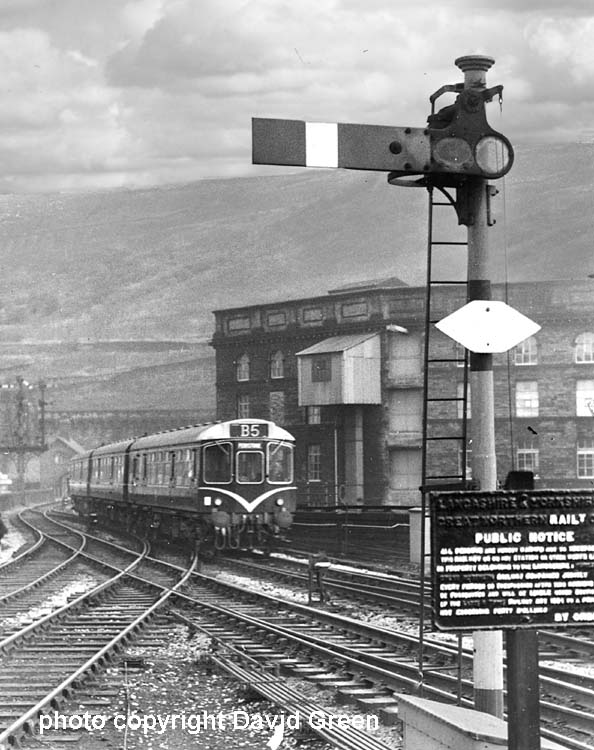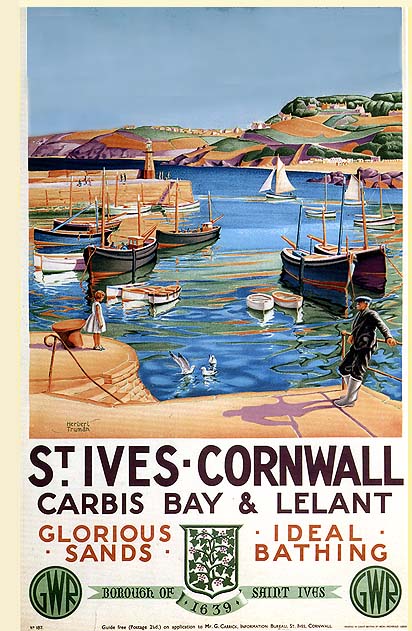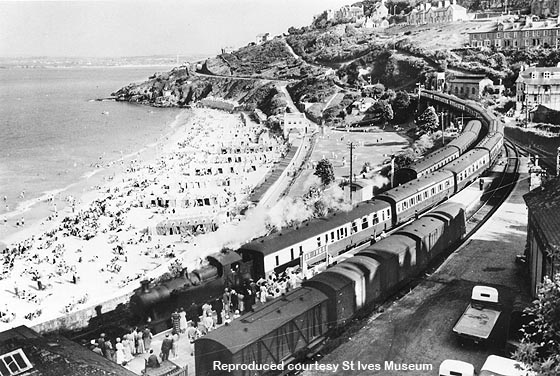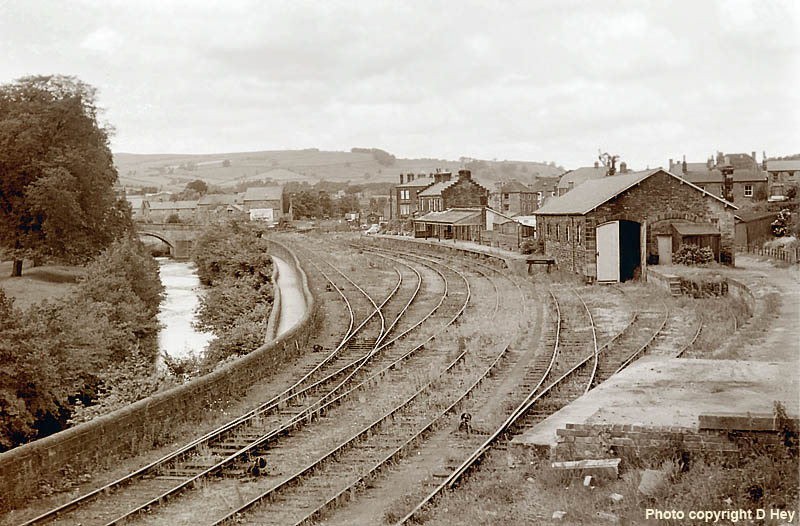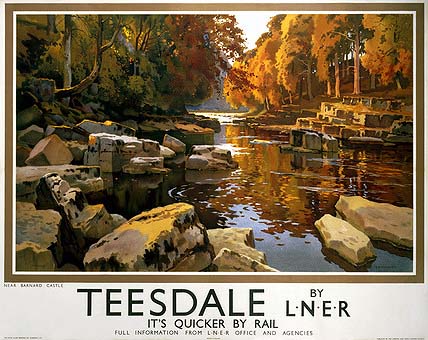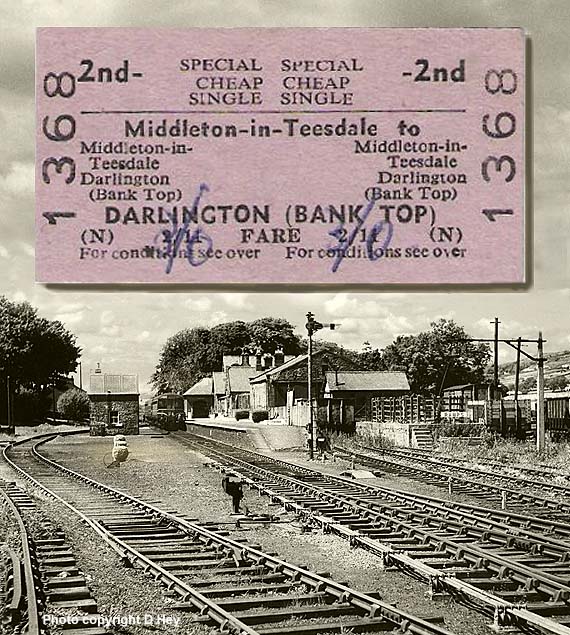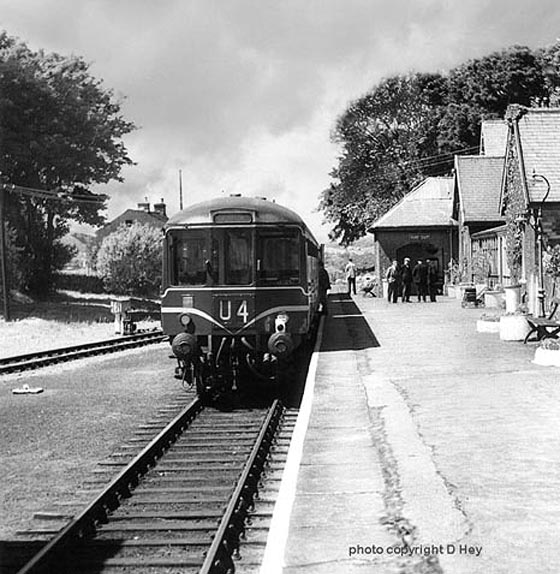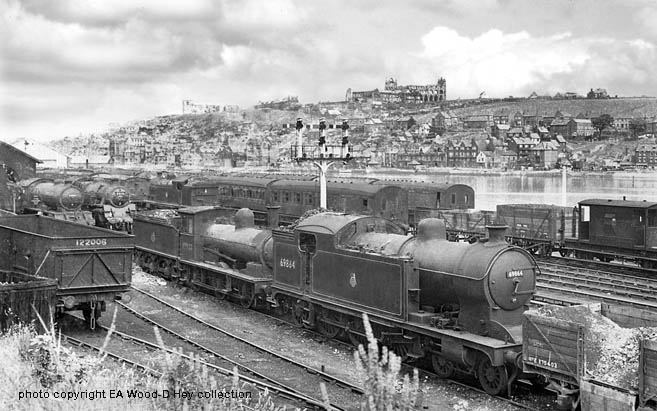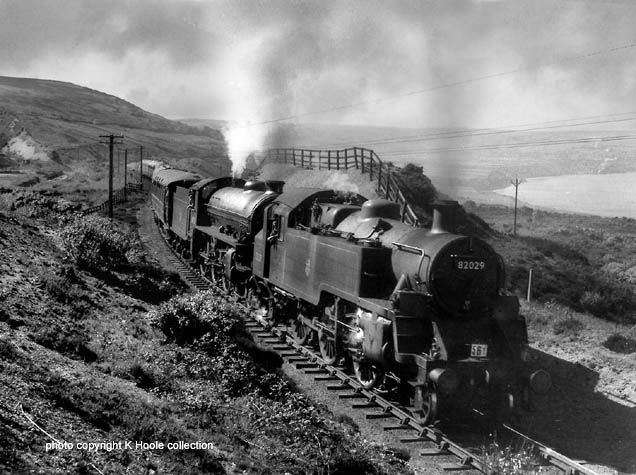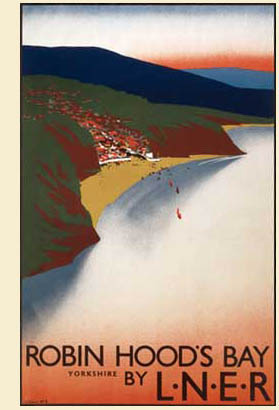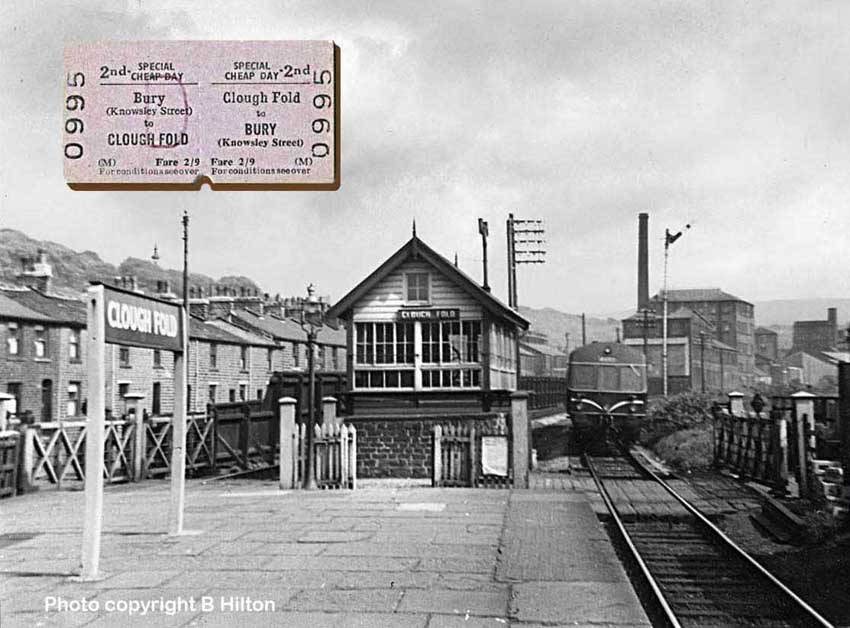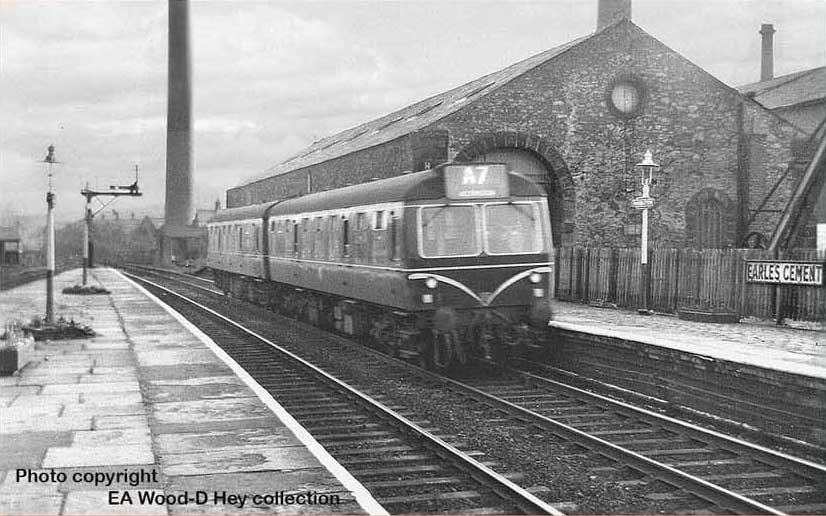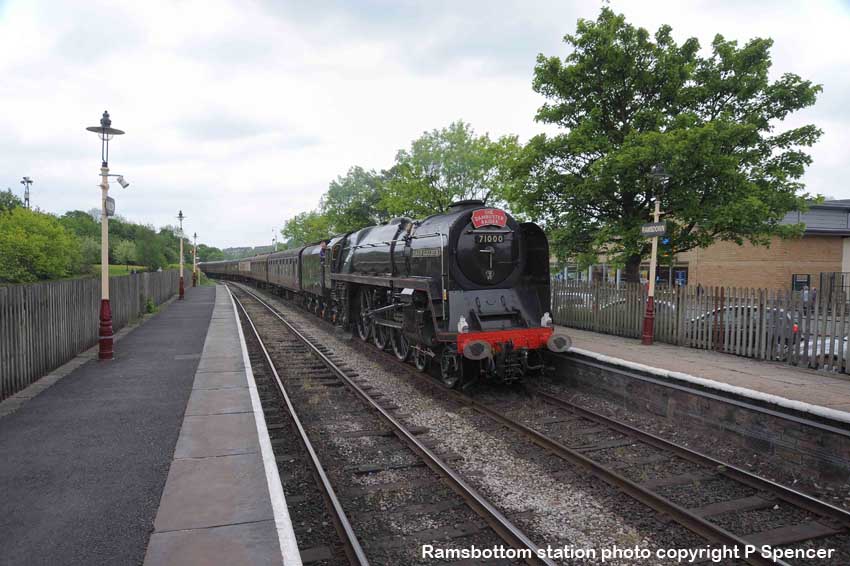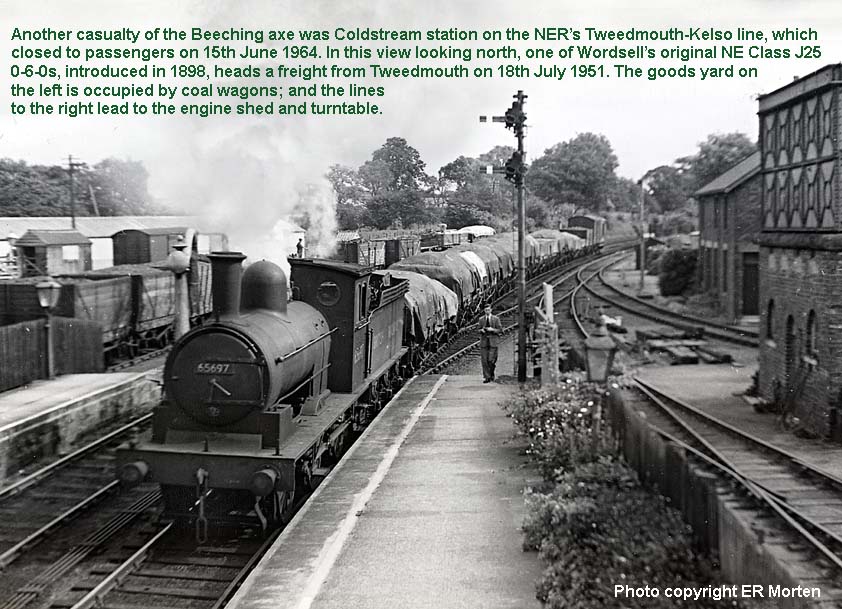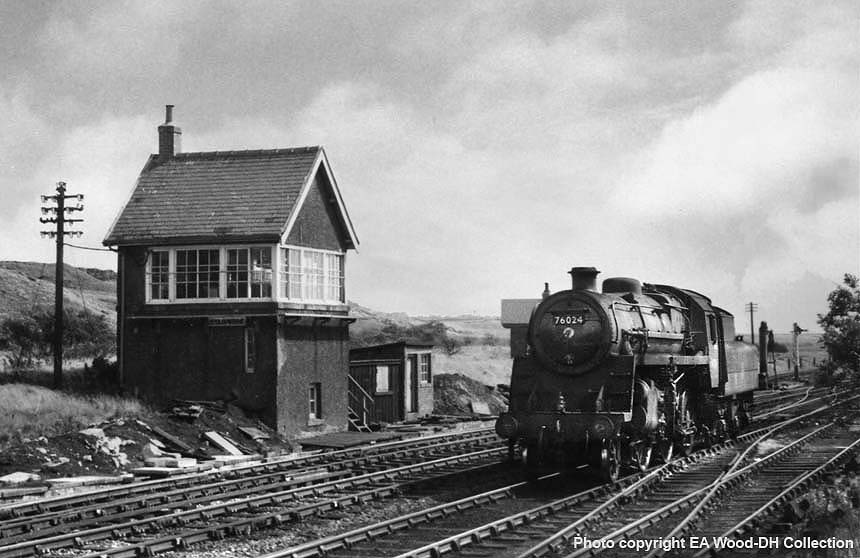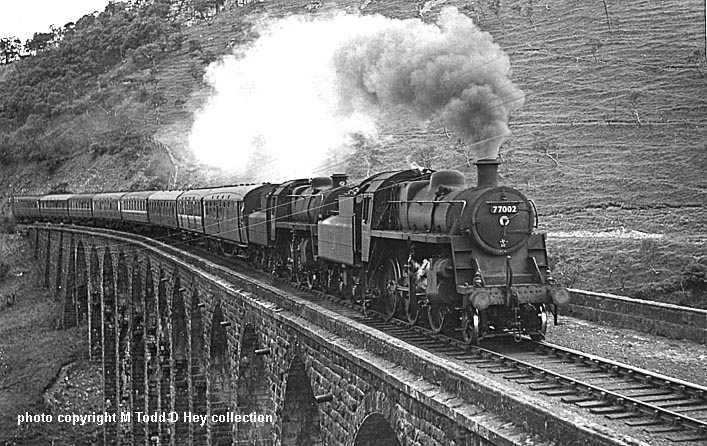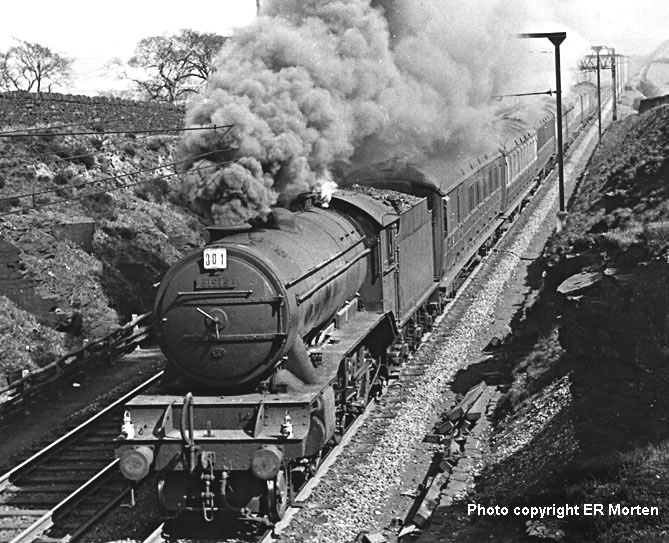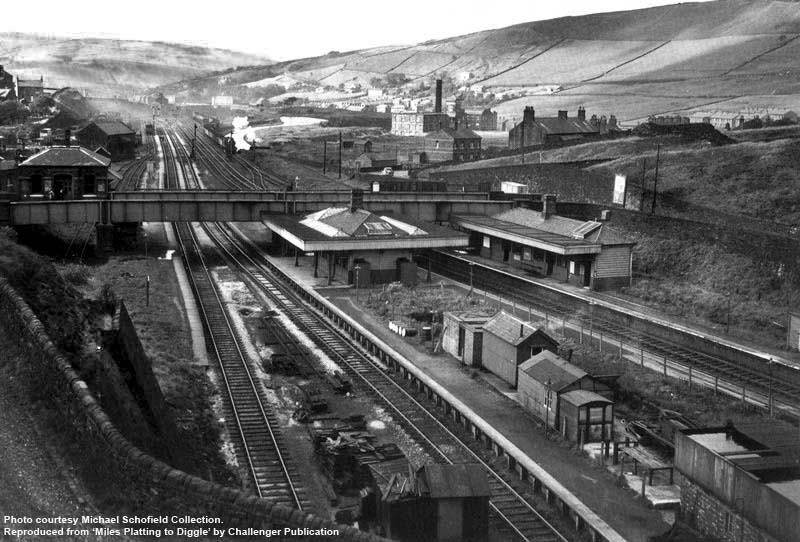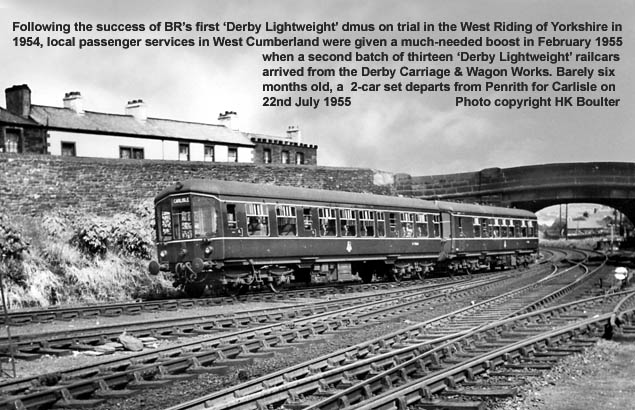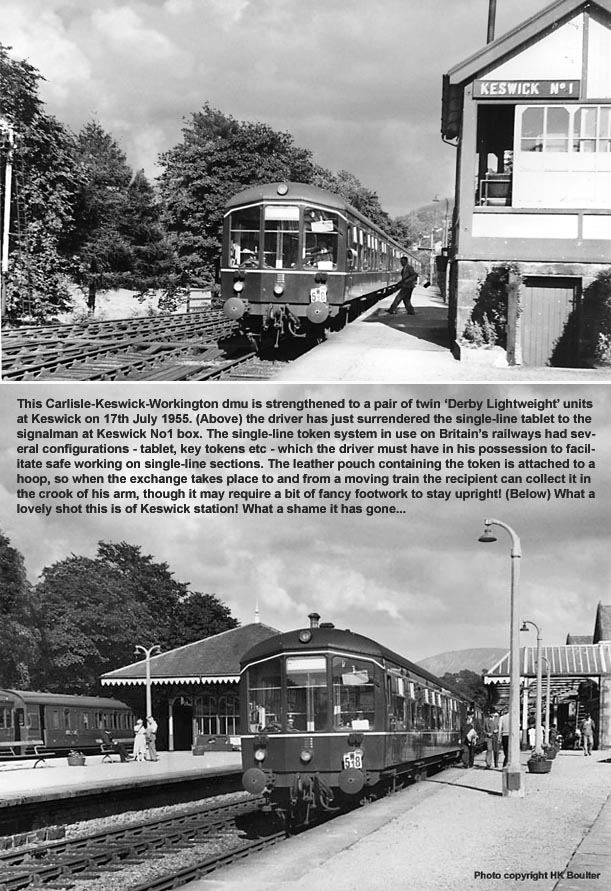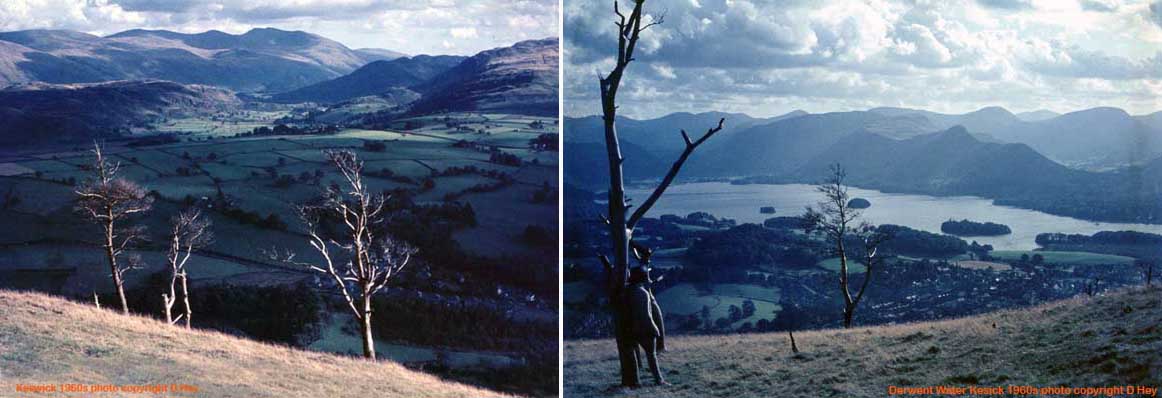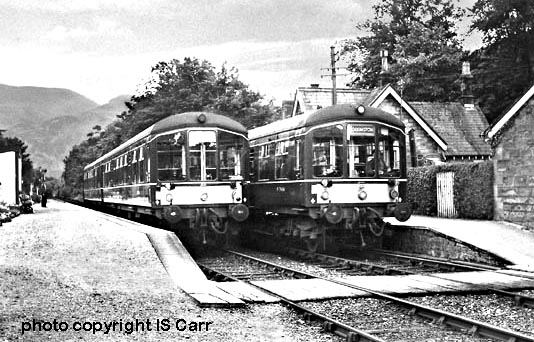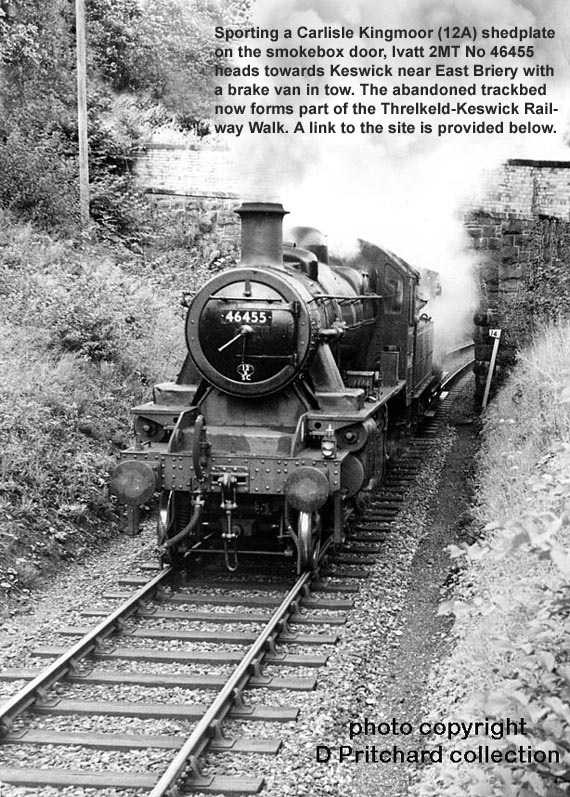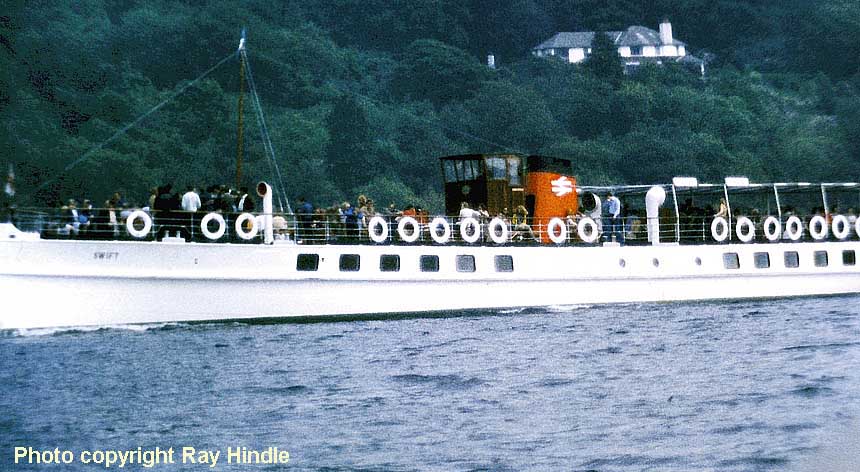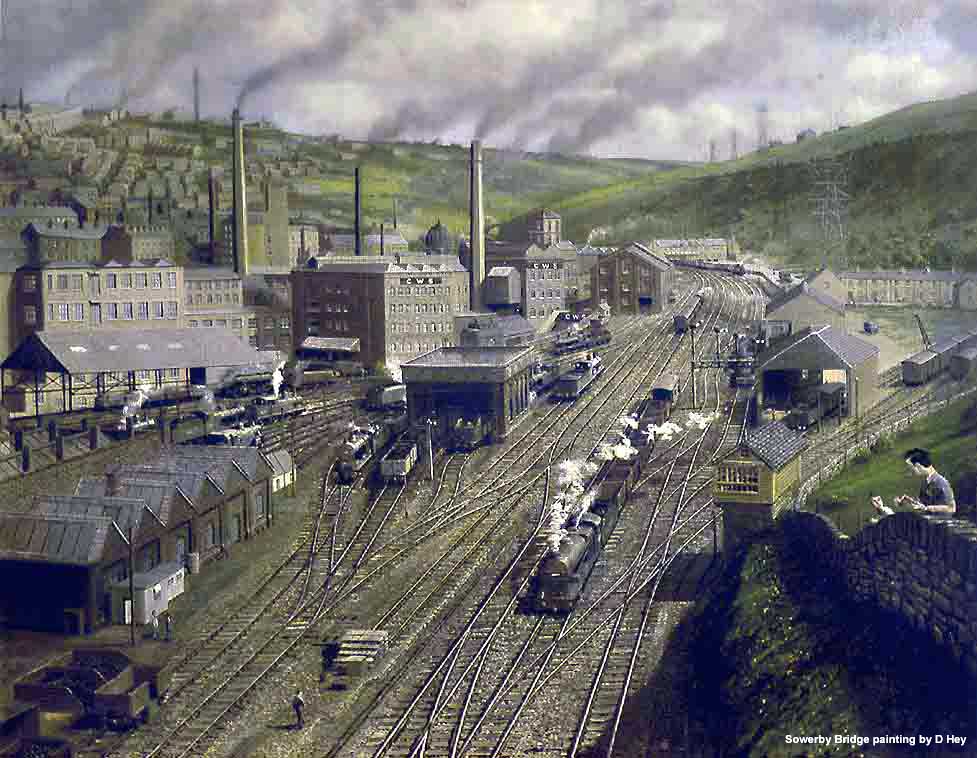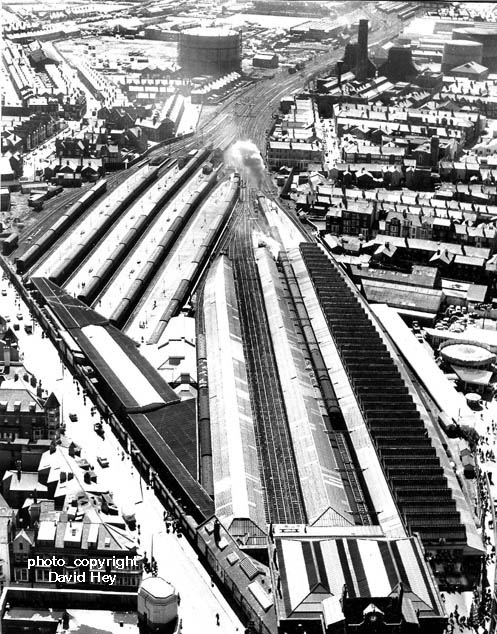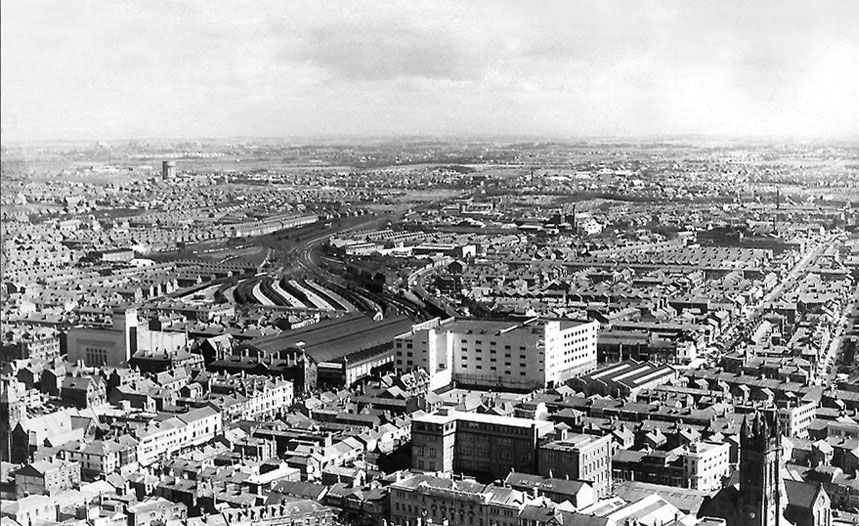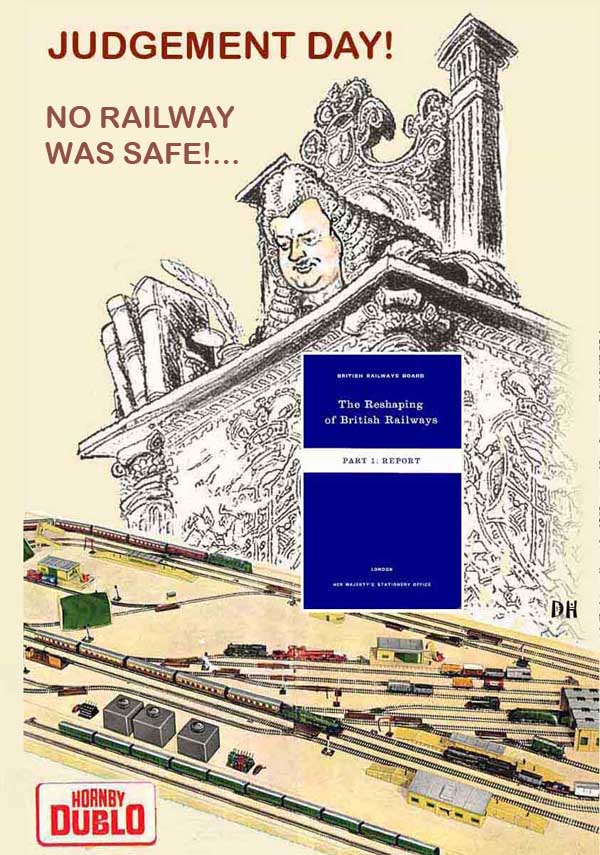 From the perspective of our modern world, the memories I have of post-war Britain convince me that I must be much older, since many of the things I remember as a child have either been consigned to the scrapheap or found their way into railway museums. When people hark back to the Fifties, they recall how plain and ordinary it all seemed, for the world appeared to have stood still since before a war that grown-ups still talked about as if it had ended the day before yesterday. There is a huge generation gap between those who remember the war and those who didn't, and the same can be said for the youngsters who were born in steam days and the next generation who found themselves caught up in the enervating years of dieselisation that followed.
From the perspective of our modern world, the memories I have of post-war Britain convince me that I must be much older, since many of the things I remember as a child have either been consigned to the scrapheap or found their way into railway museums. When people hark back to the Fifties, they recall how plain and ordinary it all seemed, for the world appeared to have stood still since before a war that grown-ups still talked about as if it had ended the day before yesterday. There is a huge generation gap between those who remember the war and those who didn't, and the same can be said for the youngsters who were born in steam days and the next generation who found themselves caught up in the enervating years of dieselisation that followed.
Sadly I missed the 'Big Four' railway companies that were amalgamated to form the new British Railways in 1948. By the time I began train spotting in 1950 BR had done away with the LNER's Apple Green livery, the LMSR's Maroon, the Southern Railway's Malachite Green, together with the various railway companies crests and heraldic devices from coaching stock and station buildings. Even the smallest items such as cups and saucers bearing a company's logo were deemed ineligible.
Then, in 1961, Dr Richard Beeching was appointed BR Chairman and our railways would never be the same again. His penchant for back-door manoeuvrings and theoretical accountancy (a lot of closure notices were based on doctored figures) together with Transport Minister, Ernest Marples - who, incidentally, had a vested interest in motorway construction (surely a conflict of interest?) - led to the axing the rail network to a shadow of its former self.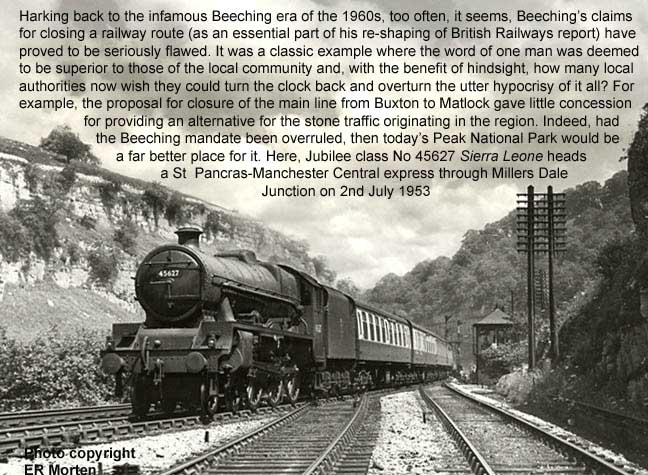
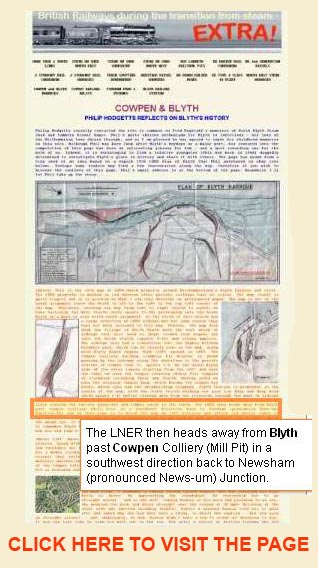 In all fairness, however, the history of Dr Richard Beeching is written almost entirely by his enemies so it is hard to know how much of it is to trusted. What we do know is that his name provokes the kind of response usually reserved for a mass murderer - a cynical assassin wielding his axe across the rail network. If only the Government had waited until the introduction of pay trains, modern signalling and unmanned stations, then the huge reduction in operating costs would surely have merited the retention of many rail services that Beeching axed.
In all fairness, however, the history of Dr Richard Beeching is written almost entirely by his enemies so it is hard to know how much of it is to trusted. What we do know is that his name provokes the kind of response usually reserved for a mass murderer - a cynical assassin wielding his axe across the rail network. If only the Government had waited until the introduction of pay trains, modern signalling and unmanned stations, then the huge reduction in operating costs would surely have merited the retention of many rail services that Beeching axed.
Indeed judging by the emails I receive, it seems the excesses of Doctor Beeching are abhorrent to most people, yet there are others who think the views expressed on this page are grossly distorted and that Beeching had no other choice. What? Of course he did! For starters he could have considered a whole raft of alternative savings, but instead he systematically destroyed the very soul of the railway network, dishing out hundreds of closure notices many of which were based on inconsistent testimonies.
Yes…okay, when Beeching was hired there were thumping losses on the balance sheet, but his cuts did little to improve matters. The bottom line is he squandered the chance to curb the number of closures, which reveals, at best, a hard-headed businessman completely lacking in empathy for the needs of local communities - and, at worst, a man so pigheaded and inflexible in his way of thinking that he totally failed to recognize the vital role that Britain's railways have to play. It begs the question why he was hired as British Railways chairman in the first place…no, I don't get it either!
(Above right-Below) Link to Phil Hodgett's superb page of the Port of Blyth in Northumberland before and after Beeching. (Below) The introduction of Derby Class 108 dmus on my local line between Leeds, Bradford, Ilkley and Skipton were not the saviours as hoped, and on 22nd March 1965 seven intermediate stations were closed on the Aire Valley line between Leeds and Bradford Forster Square - including Calverley & Rodley below...
(Above-Below) After the acquisition of the former 'Big Four' railway companies, the newly-formed British Railways quickly eradicated all signs of previous ownership by painting out the names of the former railway companies from public notices and station signs. An example can be seen on this Lancashire & Yorkshire Railway public notice at Halifax in May 1961. In the background, a new 3-car Calder Valley dmu approaches the station with a Bradford-Penistone train. (Below) Fast-forward 20-odd years and there is much evidence of post-Beeching rationalisation to be seen in this shot of a Calderdale dmu departing on a Manchester to Leeds service.

(Above-Below) The ever-dwindling traces of closed branch lines are still comparatively easy to follow, while others have been obliterated with the passing of years. The former NE and Midland Railway route linking the triangular Arthington Junction on the Leeds-Harrogate line with the Leeds-Ilkley route at Burley in Wharfedale lost its passenger service on March 3rd 1965, involving the closure of Otley and Pool in Wharfedale stations. In misty conditions, Class J39 No 64920 takes the Otley branch at Arthington station with the daily pick-up goods from Leeds on 3rd January 1961. (Below) Since closure of the railway this view of Otley looking east from the Chevin has drastically changed; the abandoned trackbed is now occupied by the Otley bypass (A660).
But the Beeching axe was not the end of the matter! The knock-on effect led to our railway heritage being totally eradicated. Unfortunately Listed Building Status came too late to prevent the British Rail Board (BRB) making wholesale changes to the railway landscape and many fine examples of 19th Century railway architecture ended up vanishing without trace. Let's not forget that in pre-grouping days (pre-1923) railway companies built their stations on a grand scale, even on lightly-used branch lines. Many stations had magnificent frontages, ornate stonework and elegant wrought iron columns supporting glass canopies, emblazoned with insignias, heraldic shields and coats of arms from pre-grouping days. And what do we have in place nowadays? Passengers are offered basic bus stop-style shelters and 'bum-freezing' metal seating (potentially fatal for haemorrhoid sufferers) and if you want a hot drink, it is served in a polystyrene cup along with a plastic stick for a spoon! Surely I am not the only one who deplores this wishy-washy modernism?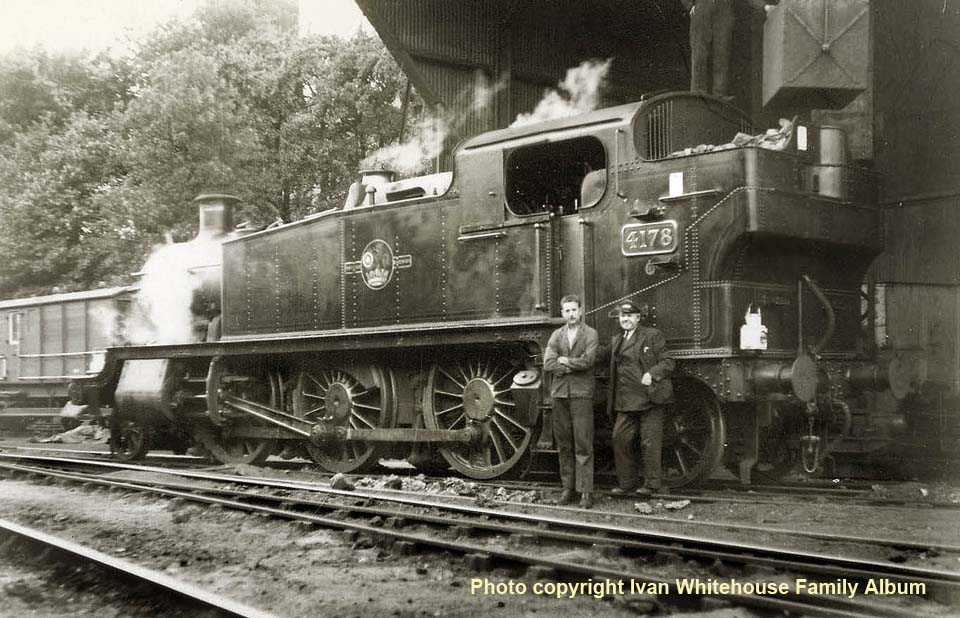
(Above-Below) 'LAST TRAIN TO MUCH WENLOCK'. In case you're wondering this website is free of financial rewards, which doesn't mean to say that I am somehow left wanting. On the contrary, the most rewarding part of constructing this website is the generous help from contributors. I have just received a chatty email from Ivan Whitehouse, who writes: 'Thanks for an excellent website; something for everyone. I am sending you two photos of my uncle Jack Darral, a driver from Wellington Shed (Salop) who worked the last train from Wellington to Much Wenlock and return, with an ex-GWR 2-6-2T No 4178 on Saturday, 21st July 1962...the line closed on Monday 23rd July 1962. These photos of the 'Beeching Special' were passed to me through the family. The name of the Fireman is Terry Thorpe and the two guards were Fred Clarke and Bert Griffiths. I understand the photos have never been published before. I hope you can put these on your website to share with others. I was a fireman on the Midland Bushbury Shed (3B) from 1957 to 1963…' Thanks Ivan…the help I receive from contributors like you makes the compilation of this website all the more worthwhile.
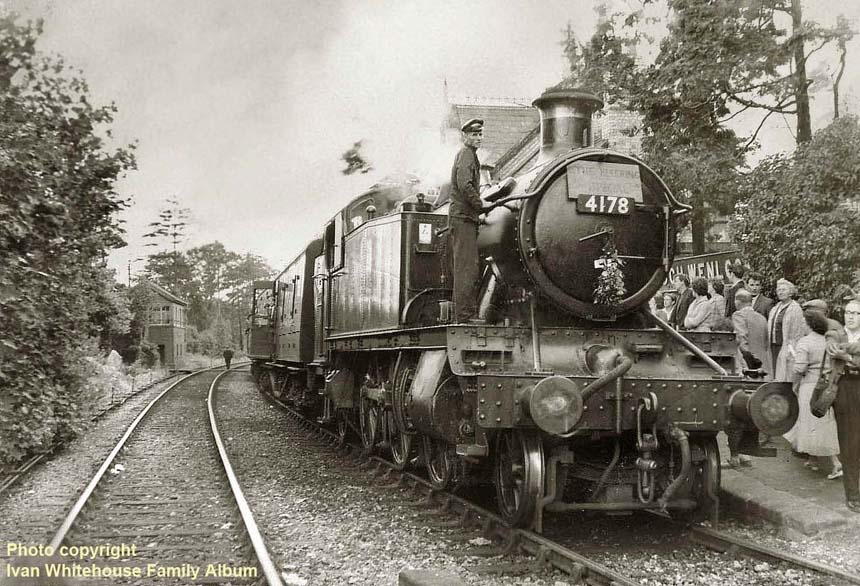
CORNISH SURVIVOR
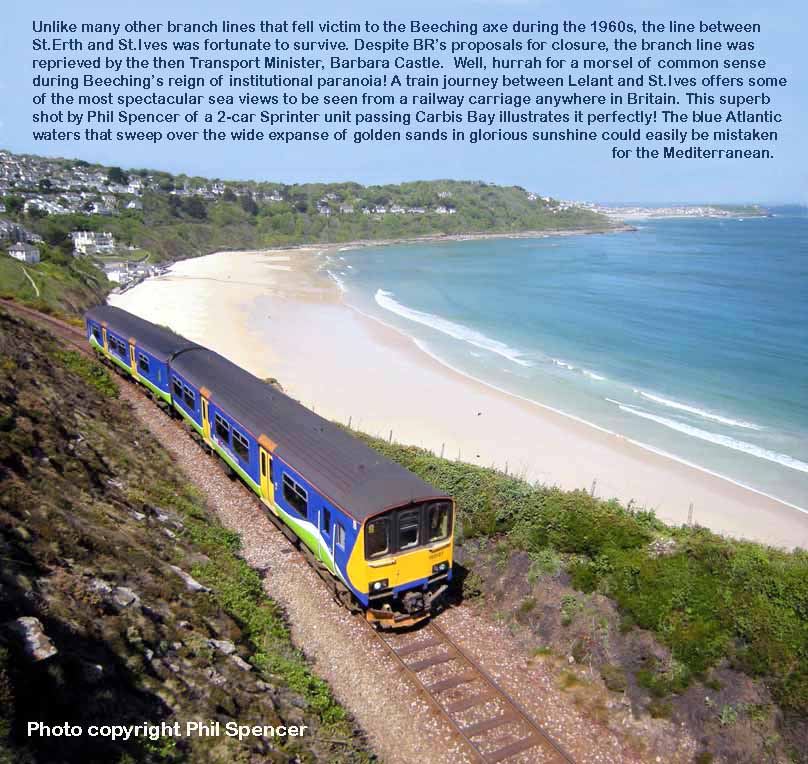
(Above) Check out Phil Spencer's 'Rail Cameraman' page 30 for photos of the St.Ives branch.
(Above Left-Right) Prior to nationalisation in 1948, the 'Big Four' railway companies commissioned a number of artists, including members of the Royal Academy, to produce a high standard of artwork for railway travel posters. The companies were keen to promote the most beautiful parts of the country through which their lines served, and in particular the GWR wasted no time in publicizing the holiday destinations in the West Country. Indeed during the inter-war years the popularity of many Devon and Cornish resorts was largely due to the enterprise of the GWR's publicity machine. For example, the 'Cornish Riviera' was promoted intensively not only in the UK but also in the USA, including this fine study of 'King' class No 6028 King George V1 - perhaps the company was playing on America's inordinate fondness for British royalty since the name of the engine features prominently on the poster.
(Below) The Great Western Railway and the St Ives branch in its heyday! The arrival of the 'Cornish Riviera Express' from Paddington must have been quite something! However, fast-forward to the early 1970s and although the line survived the Beeching axe the original station was closed on 23rd May 1971 and a smaller terminus built on the site of the abandoned goods shed, seen extreme right of photo - all goods traffic had been withdrawn on 9th September 1963. This shot (below) of the 'Cornish Riveria Express' is posted courtesy of the St Ives Museum, which is situated in the old fishing quarter overlooking St Ives Bay. The museum houses displays and collections relating to this beautiful Cornish town. Click on photo to visit the website.
NORTH YORKSHIRE CASUALTIES
During the Sixties, train spotters watched in open-mouthed astonishment as the mindless excesses of the Beeching era slashed the rail network to a fraction of its former self. Fair enough - competition from road haulage was hitting the rail freight business hard, and as the freedom of the open road beckoned, more and more families were turning their backs on public transport and buying their first car. In 1961, when Dr Richard Beeching became the new Chairman of British Railways, he had one purpose in mind - to make our railways pay - hence he wasted no time in axing the least-profitable lines. But what did it all mean? What was achieved by his orgy of cutbacks? Because it had absolutely nothing to do with the needs of rail travellers, and unlike our European counterparts, it gave little concession for providing a public service.
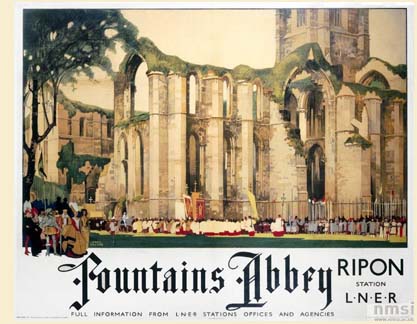 (Above-Right-Below) In pre-Grouping days (pre-1923) our railway network was anything but integrated, with several towns and cities served by duplicated routes. When Beeching became BR Chairman, many sizeable towns were removed from the railway map altogether, which included the Cathedral city of Ripon between Harrogate and Northallerton in North Yorkshire. Following completion of four tracks on the ECML between York and Northallerton, serious doubts were raised about the Ripon line as a through route when the majority of trains that used the line were re-routed via York. In 1967, all trains between Harrogate and Northallerton were withdrawn and the track lifted soon after. (Above) Class B1 No 61353 heads a southbound train past Ripon signal box. (Right) The LNER's publicity machine at work - in 1933 artist Fred Taylor (1875-1963) was commisioned to produce a painting of Fountains Abbey, which he has done admirably - a poignant reminder that so many of the travel posters in the NMSI collection feature the names of railway stations subsequently axed by Beeching. (Below) The southbound 'Queen of Scots' Pullman crosses the Nidd Viaduct on the now-closed Harrogate-Ripon-Northallerton line.
(Above-Right-Below) In pre-Grouping days (pre-1923) our railway network was anything but integrated, with several towns and cities served by duplicated routes. When Beeching became BR Chairman, many sizeable towns were removed from the railway map altogether, which included the Cathedral city of Ripon between Harrogate and Northallerton in North Yorkshire. Following completion of four tracks on the ECML between York and Northallerton, serious doubts were raised about the Ripon line as a through route when the majority of trains that used the line were re-routed via York. In 1967, all trains between Harrogate and Northallerton were withdrawn and the track lifted soon after. (Above) Class B1 No 61353 heads a southbound train past Ripon signal box. (Right) The LNER's publicity machine at work - in 1933 artist Fred Taylor (1875-1963) was commisioned to produce a painting of Fountains Abbey, which he has done admirably - a poignant reminder that so many of the travel posters in the NMSI collection feature the names of railway stations subsequently axed by Beeching. (Below) The southbound 'Queen of Scots' Pullman crosses the Nidd Viaduct on the now-closed Harrogate-Ripon-Northallerton line.
(Above-Below) Back in the Sixties, both the Beeching cuts and the demise of steam overshadowed everything, but worse things were happening in the rest of the world, such as the Cold War and the building of the Berlin Wall. On the very same day the German city was divided, I was taking photographs of a Derby Class 108 3-car set arriving at the North Yorkshire terminus at Richmond on August 13th 1961. Blimey! When I think of the puny concerns I had over the camera's optimum 'f' stops and shutter speeds, it pales into insignificance compared to the injustices going on in the rest of the world. Although the former NER branch to Richmond was closed by Beeching in March 1969, the train shed has remarkably survived thanks to the efforts of the Richmond Station Preservation Trust.

(Above) In spite of the hardship the closures brought, it could be argued that some drastic action was needed to halt BRs plummeting finances. If one accepts the figures quoted for the basic maintenance of some branch lines - £77 per mile each week, plus the cost of steam operation at £168 per mile each week - then BR made a very plausible case for closure and it is surprising that some branch lines stayed open for as long as they did. One example was the Pateley Bridge branch situated in one of the most beautiful areas of the Yorkshire Dales. BR could hardly justify the retention of the line which lost its passenger service in March 1951 but remained open for goods traffic until October 1964. It is unlikely that the revenue earned from the goods collected by Class K1 No 62038 for the return trip to Starbeck in June 1963 would have covered the crew's wages.
(Above-Right-Below) The stunning images from the NMSI Collection Online show the quality of poster art to be seen on station platforms across the country. This London & North Eastern Railway poster - 'North East Dales' was painted by Edwin Byatt in 1946. The artist depicts a farmer with a flock of sheep walking towards a castle in the foreground, with a river valley and abbey below. This artist's impression could be Bolton Castle in Wensleydale or it is more likely to be Barden Towers in Wharfedale with the ruins of Bolton Abbey  in the distance, however on close inspection it would appear the Wharfe river is flowing upstream! Still the picture does convey something of the wonderful character of the Yorkshire Dales, and so despite the artist's dalliance with the laws of gravity - plus Beeching's closure of the line between Ilkley and Skipton - it is still possible to travel there by train on the lovely Embsay & Bolton Abbey Steam Railway thanks to a dedicated group of volunteers. Click HERE for details.
in the distance, however on close inspection it would appear the Wharfe river is flowing upstream! Still the picture does convey something of the wonderful character of the Yorkshire Dales, and so despite the artist's dalliance with the laws of gravity - plus Beeching's closure of the line between Ilkley and Skipton - it is still possible to travel there by train on the lovely Embsay & Bolton Abbey Steam Railway thanks to a dedicated group of volunteers. Click HERE for details.
For the record, the NMSI family is comprised of four award-winning museums, each with their own diverse identity: the Science Museum, the National Media Museum and the National Railway Museum (NRM) at York. The Science Museum at Swindon houses a massive collection ranging from the iconic Lockheed Constellation airliner to super computers, bicycles and the last Fleet Street printing press. However, the NMSI's full collection is so big that only 8% of the artefacts are on public view. The rest are hidden-away on an ex-WW2 airfield just off the M4, but enthusiasts are amply compensated by the NMSI Collections Onlin; it is a superb website which displays more than 230,000 objects including a range of the NRM's railway posters...a visit HERE is highly recommended. (Below) This magnificent poster of the River Tees near Barnard Castle (below) would grace any living room; it was painted by Ernest William Haslehurst (1866-1949).
(Above-Below) This scene of Middleton-in Teesdale is typical of a country branch line terminus; ash trackbed, bullhead rail, cattle dock, point rodding and run-round loop. Here Ivatt Class D3 4-4-0 awaits departure with some interesting North Eastern Railway stock circa 1920s. (Below) Fast-forward forty-odd years and the run-round loop remains, but this time a 3-car Birmingham Railway Carriage & Wagon Co dmu (later TOPS Class 104) awaits departure from the terminus on the Barnard Castle and Darlington service in June 1960. Prior to closure on 30th November 1964, the Middleton-in-Teesdale branch diverged from the Penrith-Darlington line that ran via Kirby Stephen and Stainmore Summit across the Pennines (see below). Photos © D Hey
(Above-Below) The Yorkshire coastal town of Whitby lies deep within ex-North Eastern Railway territory, but of the four routes that converged on the resort, only the Esk Valley line now survives. The Whitby-Loftus line was closed in 1958 (pre-Beeching) followed seven years later with the withdrawal of the scenic coastal route to Scarborough and the line to York via Pickering, both victims of the Beeching cuts in March 1965. The old steam shed was situated in a picturesque setting overlooking the harbour. Here, Class A8 4-6-2T No 69864, Class J27 0-6-0 No 65847, D49/2 No 62742 The Braes of Derwent and Standard 2-6-4T No 80116 await their next turn of duty. (Below) The surviving shed building can be seen in this super-wide image of a pair of 2-car units departing from Whitby in June 1987. The twin railbuses built by W Alexander/A Barclay were designated Class 143 and made their debut in 1985. Sadly, the good looks of the new vehicles were let down by their solid interior bulkheads behind the driver's cab which denied passengers both front and rear views over some of the most picturesque lines which BR was keen to promote.
There are always two sides to every story, of course, and this is particularly the case concerning the Beeching axe, an emotive subject deserving a more balanced opinion than perhaps the one expressed on this page. Fair enough, my views are those of a red-blooded enthusiast hence the reason I am scathing in my attack on Beeching's philosophy. However I am not entirely blinkered by furore and agree that some form of drastic action was needed to halt BRs chronic plummeting finances...it would be wrong to suggest otherwise. Year after year BR's balance sheet kept dipping deeper into the red, therefore Beeching made a very plausible case for axing the most unprofitable branch lines. It offered a guick-fix solution. But full-blown closure and ripping up track en masse was not the only answer. The introduction of pay trains, modern signalling and unmanned stations would have provided a huge reduction in operating costs that surely merited the retention of rail services, especially in the most populated areas.
But alas this came too late, and as Dr. Chris Warburton Brown points out in a recent email (below) - 'We shouldn't judge the past by the standards of the present...'
Now that one sentence alone struck a chord with me; it is a very valid point and I feel Dr. Chris Warburton Brown's full email is worthy of inclusion here; he writes...
'Hello David,
First of all, let me say how much I enjoyed your site and all the amazing photos of railways of yore.
However I think that you, like so many current commentators, are rather harsh on Beeching. I say this as a committed lefty who works for an environmental charity, is building a model railway, and who doesn't drive, so I have a number of reasons to hate what Beeching did to the rail network!
Neverthelss, I am also a historian and as such I would argue that we shouldn't judge the past by the standards of the present. The railways are currently enjoying a boom, with passenger numbers the highest since the early 50sand widespread overcrowding on trains (and on the motorways too). And as oil prices rise and the roads become more crowded, we may see a move of freight back on to the rails. But none of this was obvious in the early 60s. The railways seemed old and tired, a creaking 19th century infrastructure that wasn't fit for the white heat of the modern economy. Passenger numbers were declining steadily and freight revenues had fallen through the floor. It seemed like roads were the transport of the future.
Even if Beeching had known that rail would undergo its remarkable renaissance four decades later, many of the lines that he (and his predecessors and successors) closed would still be entirely uneconomic today. In Northumberland, the area I know best, long rural branch lines serving small villages were not cost effective, and wouldn't be today; many of the lines closed can't even support a regular bus service! The Border Counties line, Alston branch, Wannie line, and Coldstream branch could never have been economically viable; they barely were even in the years before the First World War. Many of the branch lines closed in East Anglia, Scotland and the south west peninsula are just the same. A whole other group of lines were originally created for the transportation of either coal, steel or iron. Coal, not passengers, was the backbone of the LNER despite Gresley's best efforts with Mallard et al; and still the LNER was only just profitable The Middleton in Teesdale, Consett, and Redcar to Whitby lines fit this pattern, as do most of the closed lines around the Tyne and the Tees. Looked at in the cold light of day, there really was no future for these lines. This leaves a group of lines which arguably should have been kept open, like the Blyth line, the line along the north bank of the Tyne to Scotswood and the line through Washington. These are mostly short lines in densely populated areas, not the romantic rural banch lines so beloved of Beeching's detractors. A number of the commuter stations closed on lines that survived the axe should also probably have been kept. But potentially viable rural lines like the Waverley Route and the Penrith-Keswick branch are very much the exceptions, not typical of what Beeching cut. Perhaps one in ten of the railway miles Beeching et al closed should, in hindsight, have been kept open.
What Beeching did was prune the network to keep a viable trunk preserved while cutting out most of the dead wood. In doing so he laid the foundation for preserving the railways as a viable form of transport for the fiuture, and left a sound base for some re-building and redevelopment in the years after 2012. Without Beeching, the rail network could well have suffered death by a thousand cuts, eventually withering away almost completely.
In fact I believe this was exactly what was proposed under the second Wilson government, luckily resisted by transport minister Barbara Castle. All-in-all the railway network he created has survived the test of time pretty well, with almost all Britain's major towns and cities still well served by regular trains. I won't go so far as to propose a toast to Beeching, but overall I think an objective analysis, free from the sentimentality which steam branch lines so easily produce in all of us, leads to the conclusion that he was a friend rather than an enemy of Britain's railways.
Best wishes and thanks for all your hard work on a great web site...
Dr. Chris Warburton Brown...'
(Below) As people grow older nostalgia becomes embedded in everyone's consciousness and these photos revive memories of family holidays to Scarborough on the Yorkshire coast during the late 1950s. The most enjoyable part of the week was taking a round-trip excursion by dmu to Whitby via Malton and Pickering, returning along the scenic coastal route via Robin Hood's Bay. In those days (pre-Beeching) the rail journey between Scarborough and Whitby was some 18 miles...today the same trip by rail (via York, Darlington and Middlesborough) is 160 miles! (Below) Standard Class 3 2-6-2T No 82029 pilots Class B1 No 61237 George H Kitson on the 3-mile climb at 1 in 39 from Robin Hood's Bay to the summit at Ravenscar with a train for Scarborough.
(Above-Below) These photographs could well be a 'stills' from the opening titles of the 'Thomas the Tank Engine' TV series. The viaduct at Staithes on the Yorkshire coast was the largest of five similar structures on the line between Whitby and Redcar. Local passenger services were operated by Thompson L1 2-6-4Ts which were more than capable of handling the severe gradients and curvature of the line. 

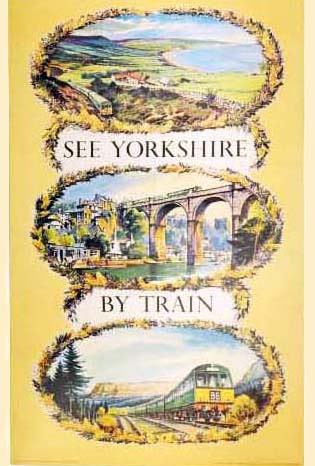 (Above-Inset-Below) During NE days, coastal corrosion forced the company to reroute the line involving a detour through two tunnels before regaining the original alignment at Kettleness. In this view, a rather grubby Ivatt 2-6-0 No 43076 crosses the viaduct on arrival at Sandsend - the first station north of Whitby - with a local train for Middlesborough. Since closure of the line in 1958 the A174 road from Whitby to Middlesborough now occupies the alignment of the single track in the background. Click on photos to view larger size. (Inset Left) This British Railways double royal poster, 'See Yorkshire by Train' by A Carr Linford, features the introduction of BR's new diesel multiple unit service in spectacular Yorkshire scenery; the three views show a dmu climbing from Robin Hoods Bay to Ravenscar, crossing Knaresborough Viaduct and passing through Newton Dale south of Goathland. The poster went under the hammer for £240 at a Great Central Railway Auction in July 2010. (Below) Although the Whitby-Redcar route was closed to passengers on May 5th 1958, part of the branch survived as a freight-only line to Skinningrove - an additional section was relaid as far as Boulby in April 1974 to carry the output from the Cleveland Potash Mine in purpose-built wagons. This is a panoramic view of the rugged coastline showing Class 31s Nos 31210 and 31320 departing Skinningrove with a Boulby-Teeside potash train along the clifftop on May 18th March 1986.
(Above-Inset-Below) During NE days, coastal corrosion forced the company to reroute the line involving a detour through two tunnels before regaining the original alignment at Kettleness. In this view, a rather grubby Ivatt 2-6-0 No 43076 crosses the viaduct on arrival at Sandsend - the first station north of Whitby - with a local train for Middlesborough. Since closure of the line in 1958 the A174 road from Whitby to Middlesborough now occupies the alignment of the single track in the background. Click on photos to view larger size. (Inset Left) This British Railways double royal poster, 'See Yorkshire by Train' by A Carr Linford, features the introduction of BR's new diesel multiple unit service in spectacular Yorkshire scenery; the three views show a dmu climbing from Robin Hoods Bay to Ravenscar, crossing Knaresborough Viaduct and passing through Newton Dale south of Goathland. The poster went under the hammer for £240 at a Great Central Railway Auction in July 2010. (Below) Although the Whitby-Redcar route was closed to passengers on May 5th 1958, part of the branch survived as a freight-only line to Skinningrove - an additional section was relaid as far as Boulby in April 1974 to carry the output from the Cleveland Potash Mine in purpose-built wagons. This is a panoramic view of the rugged coastline showing Class 31s Nos 31210 and 31320 departing Skinningrove with a Boulby-Teeside potash train along the clifftop on May 18th March 1986.

(Above) During early pre-Grouping days (pre-1923) the railway companies produced the simplest posters to advertise their various routes and services on printed sheets. However with improvements in printing 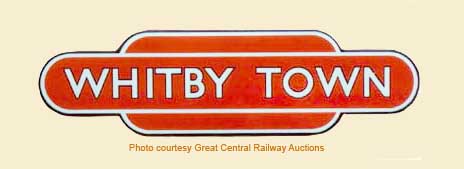 technology, it wasn't long before much bolder pictorial images of landscapes and historical subjects began to appear; the style of these posters was greatly influenced by the use of graphic artists who produced images that reflected the changing patterns of fashion and lifestyles in British society during the first part the Twentieth Century. Indeed many iconic images appeared on railway travel posters, including John Hassall's famous 'Jolly Fisherman' which will always be
technology, it wasn't long before much bolder pictorial images of landscapes and historical subjects began to appear; the style of these posters was greatly influenced by the use of graphic artists who produced images that reflected the changing patterns of fashion and lifestyles in British society during the first part the Twentieth Century. Indeed many iconic images appeared on railway travel posters, including John Hassall's famous 'Jolly Fisherman' which will always be  associated with the seaside resort of Skegness in Lincolnshire.
associated with the seaside resort of Skegness in Lincolnshire.
(Right) Canadian-born artist, Gryth Russell (1892-1970) produced this image of Whitby (viewed from Sandsend) for the North Eastern Region. By 1958, however, the line from Whitby to Redcar was axed...and within a few years a more sinister style of poster began to appear on station platforms - BR's alterations to timetables and station closure notices became a more familiar sight.
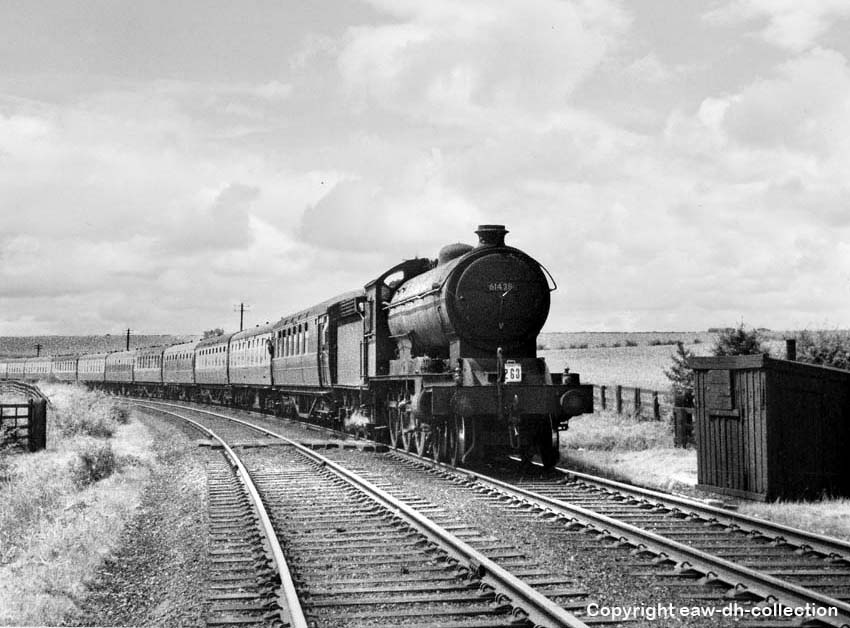
(Above-Below) Passenger services were withdrawn from many East Yorkshire lines in 1965, including the Selby-Bridlington and York-Hull routes across the Yorkshire Wolds. Class B16 heads an excursion from the West Riding for the Yorkshire Coast through Middleton-on-the-Wolds between Selby and Driffield. The Beeching axe seriously exposed the Hull-Scarborough line to the same fate, but it was reprieved when the Minister of Transport refused to consent withdrawal. The original North Easter Railway station at Bridlington consisted of an overall roof covering two platforms, later extended by an additional six platforms for the NER excursion traffic to the resort. The roof was removed in 1961, followed by the all-too-familiar 1980s rationalisation. A rare sight of a loco-hauled passenger trains shows 'Peak' class 45140 approaching the station with the 14.40 SO Scarborough-Luton in September 1983. The lines curving to the right lead into the goods yard which was used to accommodate dmus staying-over during the summer months.

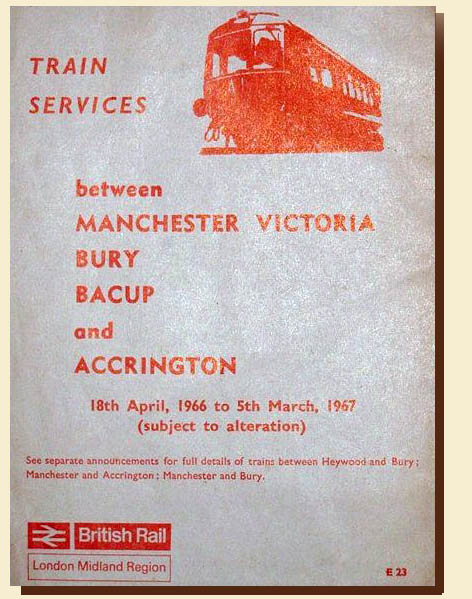 (Left) I am grateful to Mark Bartlett for allowing the use of these BR notices and his accompanying text which is featued on the excellent 'Railscot' website. Mark writes - 'Tmetable subject to alteration - and how! On 5th December 1966 most of the services in this timetable ceased and many of the lines involved closed completely. The Accrington service ran via Helmshore to Stubbins Junction, and beyond Bury to Manchester via Clifton Junction. Services from Bacup that did not terminate at Bury Bolton St continued to Manchester via Heywood and Moston - and so with the electric line, Bury had three through routes to Manchester. Perhaps the most remarkable feature of the timetable is that, until the day of closure, Bacup enjoyed a twice hourly service to Bury on weekdays increasing to every 15 minutes on Saturdays. Once the line had been cut back to Rawtenstall there was a single DMU stabled at Bury shuttling to Rawtenstall and back a mere 12 times a day Monday to Saturday and of course that service ceased in June 1972.
(Left) I am grateful to Mark Bartlett for allowing the use of these BR notices and his accompanying text which is featued on the excellent 'Railscot' website. Mark writes - 'Tmetable subject to alteration - and how! On 5th December 1966 most of the services in this timetable ceased and many of the lines involved closed completely. The Accrington service ran via Helmshore to Stubbins Junction, and beyond Bury to Manchester via Clifton Junction. Services from Bacup that did not terminate at Bury Bolton St continued to Manchester via Heywood and Moston - and so with the electric line, Bury had three through routes to Manchester. Perhaps the most remarkable feature of the timetable is that, until the day of closure, Bacup enjoyed a twice hourly service to Bury on weekdays increasing to every 15 minutes on Saturdays. Once the line had been cut back to Rawtenstall there was a single DMU stabled at Bury shuttling to Rawtenstall and back a mere 12 times a day Monday to Saturday and of course that service ceased in June 1972.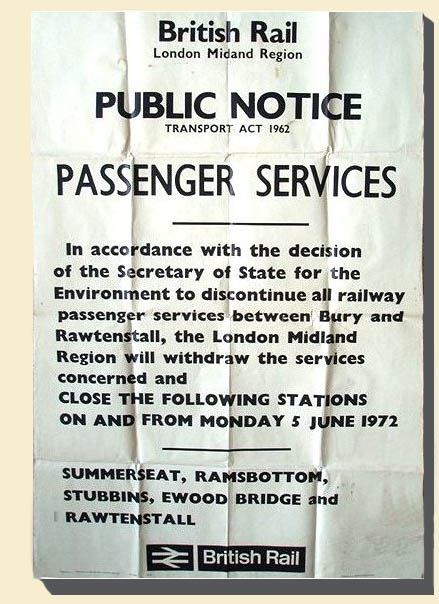 (Right-Below) The last British Rail service from Rawtenstall left at 9.05pm on Saturday 3rd June 1972 to the usual explosive detonator send off. Driver Harry Lofthouse was at the controls of the four-car DMU that had been put on for the last day trippers. Except for the first train from Bury I travelled on every service on that last day and was grateful to the ticket inspector at Bury Bolton Street who saved the closure notice for me while I was riding on the last train. Living near Rawtenstall at the time I then of course had to get the bus back home...(Below) A fleet of diesel multiple units was introduced on local rail services in 1955. In this Brian Hilton shot a 2-car Metro-Cammel unit from Bacup slows for the obligatory stop at Clough Fold in 1958. The Diesel Link drivers at Bury all remember the days when the East Lancashire lines had an intensive freight and passenger service, including through trains to London. It must have been demoralising for them to shuttle back and forth through semi-derelict stations thinking of what had gone before.
(Right-Below) The last British Rail service from Rawtenstall left at 9.05pm on Saturday 3rd June 1972 to the usual explosive detonator send off. Driver Harry Lofthouse was at the controls of the four-car DMU that had been put on for the last day trippers. Except for the first train from Bury I travelled on every service on that last day and was grateful to the ticket inspector at Bury Bolton Street who saved the closure notice for me while I was riding on the last train. Living near Rawtenstall at the time I then of course had to get the bus back home...(Below) A fleet of diesel multiple units was introduced on local rail services in 1955. In this Brian Hilton shot a 2-car Metro-Cammel unit from Bacup slows for the obligatory stop at Clough Fold in 1958. The Diesel Link drivers at Bury all remember the days when the East Lancashire lines had an intensive freight and passenger service, including through trains to London. It must have been demoralising for them to shuttle back and forth through semi-derelict stations thinking of what had gone before.
(Above) An early liveried Cravens twin unit (fitted with modified front-end design incorporating a four-panel headcode indicator) arrives at Ramsbottom on the Manchester Victoria-Accrington service. Right up to the time when the Accrington and Bacup lines closed in December 1966 Ramsbottom was a substantial station that enjoyed a service of 46 trains to Bury on weekdays, rising to 60 on Saturdays with a 15 minute interval service from Bacup. From that date a mere 12 trains ran each way per day, the buildings were demolished and the line singled in 1970. The signal cabin at Ramsbottom remained open but only to control the level crossing and an awful plywood shelter was erected on the platform. The box survived to be operated by the crews of the coal trains to Rawtenstall. Since reopening by the East Lancashire Railway the restoration work has created an outstanding preserved line station and the signal box is now controlling trains once more. I have been contacted by Daniel Jones, secretary of Ramsbottom Model Railway Club, which has a terrific website containing lots of old ELR photographs plus Holcombe Brook line photos - well worth a visit here
(Below) A final word from Mark Bartlett, who writes - 'Full credit to the East Lancashire Railway for their restoration at Ramsbottom, which includes reinstating the station buildings, up platform and wheel operated level crossing gate mechanism - plus a lot more besides!' In this present-day view, Rail Cameraman Phil Spencer captures Class 8P Pacific 71000 'Duke of Gloucester' arriving at Ramsbottom during the ELR's 1940's Wartime Weekend on Monday 31st May 2010. The eagle-eyed might spot the station sign on the lamp post reads Ramsdown, a ruse by the rail authority to confuse invading forces! More photos of the 'Wartime Weekend' can be found on Phil's page 30.
(Below) Returning to North Yorkshire, following closure of the steam shed at Whitby, Standard Class 2-6-4T was transferred to Neville Hill, joining sister engines Nos 80117-20 for duties in the West Riding. The loco is working bunker-first on the 12.30 (SO) Harrogate-Leeds via Wetherby from Collingham Bridge on January 31st 1959. No fewer than 15 members of the class have been rescued for preservation.

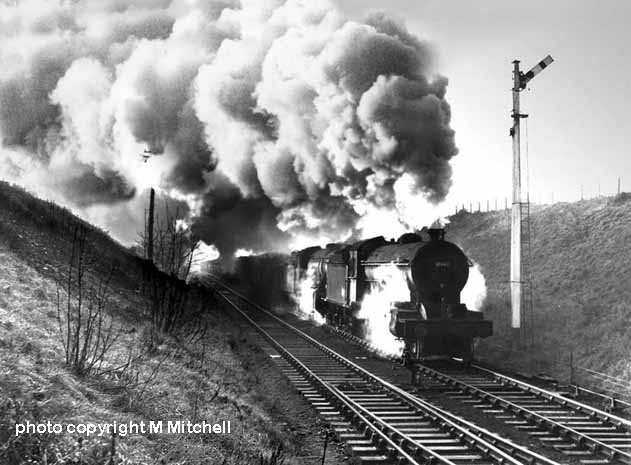
(Above-Below) Local passenger services between Leeds-Wetherby-Harrogate, and Wetherby and Church Fenton were withdrawn on January 6th 1964, involving closure of eleven intermediate stations. It was the first line in Yorkshire to fall victim to the Beeching Plan published the previous year. Due to the fierce gradients over the route, the heaviest loads required a pilot engine, and Class B16/1 No 61442 assists WD No 90435 on the 1-in-70 climb to the summit beyond Scholes between Leeds and Wetherby with a Neville Hill-Teeside freight in December 1957. Less than six months before closure, York's Class V2 No 60856 (Below) heads the 11.25 (SO) Newcastle-Llandudno past the decaying platforms at Bardsey in July 1963.
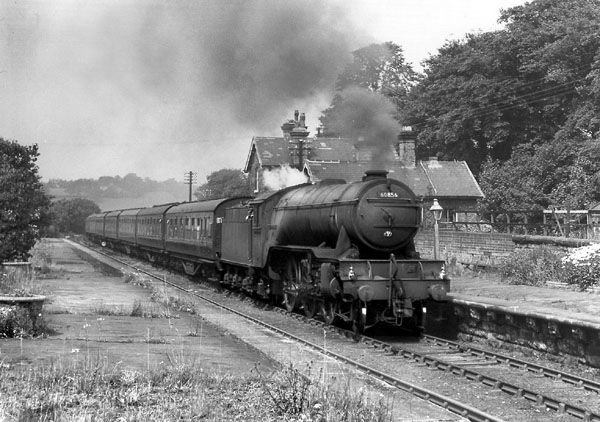
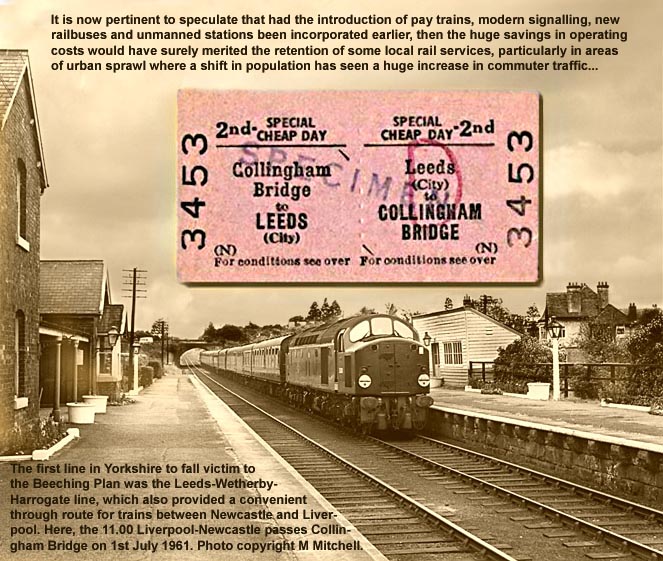
Visit Mike Mitchell's 'Rail Cameraman' page 36 for more photos of the Wetherby line
TRANS-PENNINE ROUTES WINNERS AND LOSERS
The huge number of closures was political folly of the worst kind, yet this epidemic of mismanagement still goes on today as successive Governments seek only to find 'quick-fix' solutions, rather than long-term ones. The anti--rail lobby among Whitehall bureaucrats has seldom been more ruthlessly exposed than in their treatment of British Railways after it came into public ownership in 1948 - and, in case you're wondering, this is not some crackpot train spotter's opinion either! Okay, I may be related to the 'Anorak' family, but I'm nowhere near as biased as some politicians who betray a stubborn refusal to recognise the advantages of moving heavy goods by rail. One has only to compare the motorway extravagances in Britain to illustrate the point; it screams excess, excess, excess! And what does the Government do to solve the problem? It pours billions of tax payer's money into building more! Well, it won't be long before these too are crumbling under the weight of giant-sized juggernauts laden with goods that could easily be carried by rail.
(Above-Below) The Stainmore line was built to transport Durham coke to the West Cumberland blast furnaces, and pig iron eastwards to the steelworks on Teeside. With gradients as steep as 1 in 59 between Tebay and Barnard Castle, most trains were either double-headed or banked to Stainmore Summit, which, at 1,370 feet above sea level, was the highest point of any main line in England. In this view from the west, BR Standard Class 4 No 76024 awaits its next pilot duty adjacent to Stainmore box at the summit of the 1 in 59 climb from Belah and 1 in 68 from Bowes. Unusually the box is placed gable-end towards the track, its brick construction faced with stucco for weatherproofing against the elements at this exposed spot. There are lock room windows in front and sides, the latter having the nameboard placed above it and beneath the plankwalk. The box was equipped with a 25-lever frame with only one spare and the signalmen lived in nearby railway cottages because of the isolated Pennine location. The box fell into decay from July 4th 1962 after the line was lifted. (Below) An Ivatt 2-6-0 is assisted at the rear by a BR standard Class 2 on the climb across Belah Viaduct between Kirkby Stephen and Stainmore. This spectacular structure was more than 1,000 ft long, with sixteen spans built of wrought and cast iron that carried the line 196 ft high above the valley floor. Sadly, the magnificent Belah viaduct (the highest in Britain) was demolished a year after closure of the line to all traffic in 1962. Photo © A Cawkhill.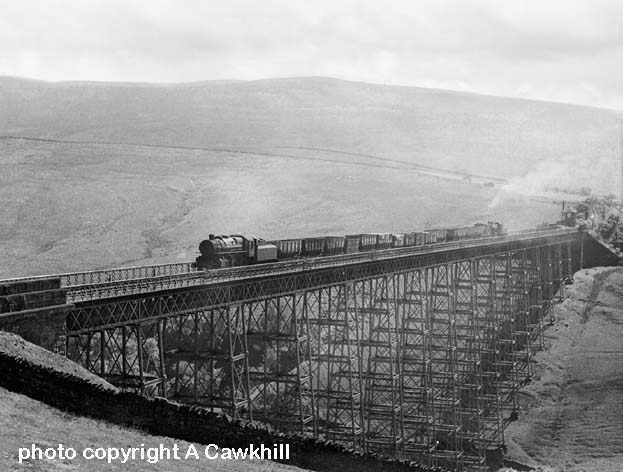
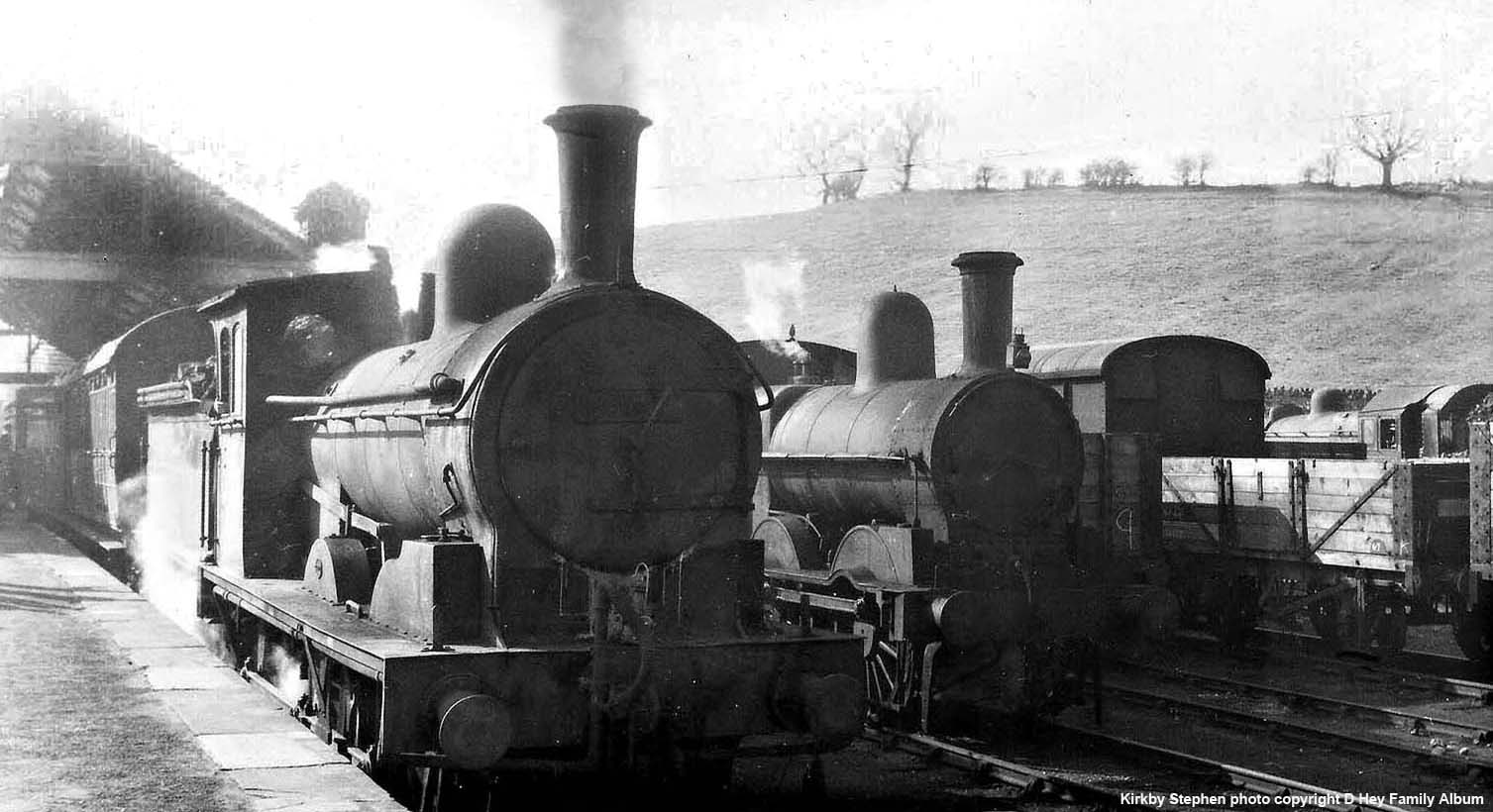
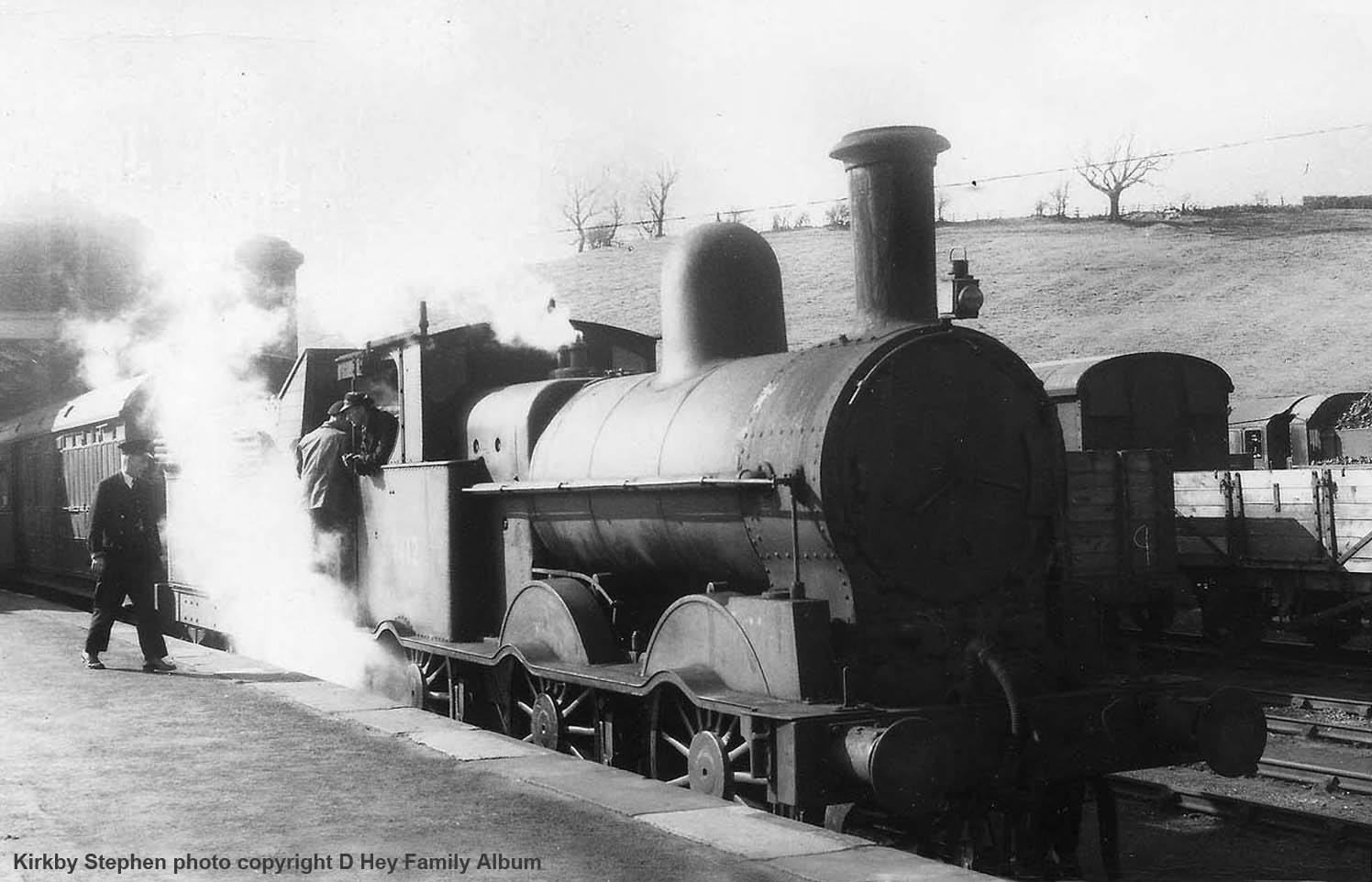
(Above-Below) Two shots of Kirkby Stephen station in the early 1950s. I barely remember these photos being taken of ex-LNWR 0-6-0 arriving at Kirkby Stephen East. All I know is that it has been in the family album for donkeys years...of interest is the wooden cover on the tender to protect train crewmen from the severity of the Pennine winters. After the lines to Penrith, Tebay and Darlington were closed for passenger traffic in 1962, the building and site fell into disrepair before it was purchased by Stainmore Properties Ltd in 1996 for use as the eastern terminus of a proposed preserved railway from Appleby East. When Stainmore Railway Company Ltd was formed in 2000, volunteers and shareholders have carried out substantial repairs to the building and begun the task of developing a Heritage Centre and operational railway. The company has been awarded a number of grants to progress the project. The Heritage Centre saw passenger trains return to the East station in August 2011 after an absence of almost 50 years. Click here to visit to SRC website. (Below) Another remarkable survivor of the 19th century railway builders is the magnificent Smardale Viaduct, situated three miles west of Kirkby Stephen on the former Stainmore route between Tebay and Bishop Aukland. After closure of the route in 1962, the once-dilapidated 553ft-long viaduct now carries a footpath and nature trail 90ft above Scardale Beck in one of the Pennine's loveliest beauty spots. Indeed, unlike most contemporary bridges spanning our motorways, the graceful lines of the viaduct actually enhance the landscape...not spoil it!
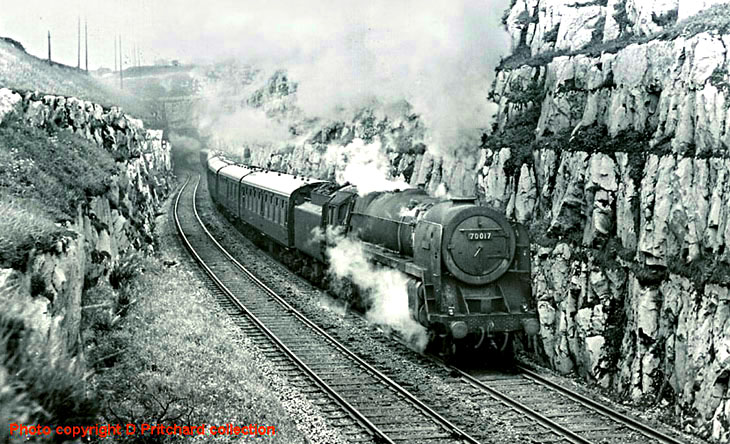
(Above) The spectacular limestone mass of the Derbyshire Peak District was a major obstacle for the Midland Railway. The topography of the area south of Chapel-en-le-Frith neccessated boring through gritstone and 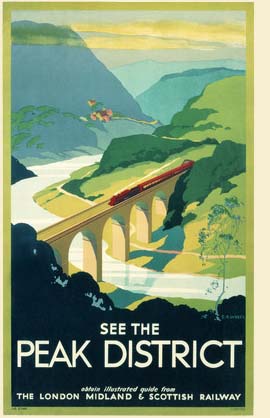 limestone under the peak of Cow Low to construct Dove Holes Tunnel. This involved a gruelling 1 in 90 climb for southbound trains from the surrounding plain to the 985-foot summit at Peak Forest. Construction began in 1860 and took five years, requiring six pumping stations to keep the workings clear of water, an underground river being encountered at one point along the way. Here, 'Britannia' Class 7MT No 70017 Arrow heads the 16.00 Manchester Central-St Pancras on the climb from Dove Holes Tunnel to Peak Forest. The closure of this Trans-Pennine route (the poor condition of the tunnel was given as a major reason for closing the line) is nothing short of a travesty, especially since the tunnel in question is still being used by trains serving the limestone quarries in the area. Meanwhile, the Peak Forest route - a major rail artery, in case it's forgotten - was closed in 1967, depriving rail pasengers of a direct link between Manchester and London via the Midlands! It was a classic case of the mindless excesses of the Beeching era.
limestone under the peak of Cow Low to construct Dove Holes Tunnel. This involved a gruelling 1 in 90 climb for southbound trains from the surrounding plain to the 985-foot summit at Peak Forest. Construction began in 1860 and took five years, requiring six pumping stations to keep the workings clear of water, an underground river being encountered at one point along the way. Here, 'Britannia' Class 7MT No 70017 Arrow heads the 16.00 Manchester Central-St Pancras on the climb from Dove Holes Tunnel to Peak Forest. The closure of this Trans-Pennine route (the poor condition of the tunnel was given as a major reason for closing the line) is nothing short of a travesty, especially since the tunnel in question is still being used by trains serving the limestone quarries in the area. Meanwhile, the Peak Forest route - a major rail artery, in case it's forgotten - was closed in 1967, depriving rail pasengers of a direct link between Manchester and London via the Midlands! It was a classic case of the mindless excesses of the Beeching era.
(Below) With closure notices gathering pace, it was not surprising that morale amongst railwaymen was at a low ebb, even in a salaried grade. Indeed, the fear of redundancy was not a good climate for staff co-operation. On July 1st 1968, all through traffic over the Peak Forest line was diverted to other routes and the track lifted north of Matlock. For the record, BR's route mileage of running lines was reduced from some 17,500 miles at the end of 1962 to approximately 14,900 in 1965, and the number of stations fell from 6,800 to 4,300. Click here to visit Nick Catford's excellent 'Disused Stations UK' website which features the line's full history, including photos, tickets and timetables plus OS Grid references to every closed station between Buxton and Rowsley...a site not to be missed!
Visit ER Morten's 'Rail Cameraman' page 52 for more photos of this line above...
(Above) A surviving Trans-Pennine route built by the Midland Railway runs between Manchester and Sheffield via the Hope Valley. A major feature is the 3,702 yard-long Cowburn tunnel where the summit of the line is situated about a quarter of the way inside the tunnel from the Yorkshire end, with a gradient of 1 in 100 falling eastwards and 1 in 150 to the west. In this classic ER Morten shot, Midland Compound 4-4-0 No 41072 emerges from Cowburn Tunnel with a local train for Chinley in May 1953. Following a further reduction of rail routes during the 1970s, the Hope Valley line was controversially given precedence over the electrified Woodhead line as the preferred passenger route between Manchester and Sheffield...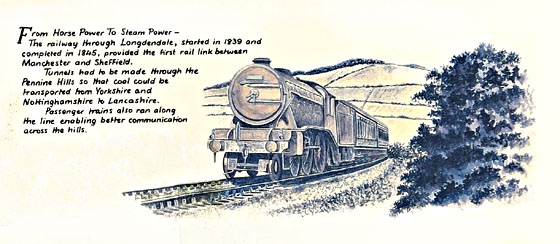
(Above-Below) A scene all too familiar nowadays is the number of abandoned railways being turned into nature trails or similar places for outdoor pursuits. There is nothing wrong with that, of course - enthusiasts would rather see our railway heritage recognised historically than buried beneath ugly industrial units and car parks. This information board at Torside is a good example. It tells the story of how the Langdendale Valley provided a vital transport link across the Pennines since the Middle Ages. It began with teams of packhorses laden with salt from Cheshire. The salt trade increased when a new turnpike road from Cheshire to Yorkshire was authorised in 1731. The railway through Langdendale was built in 1839-1845, providing the first rail link between Manchester and Sheffield. Odd then, that the designers of the sign have used an old-fashioned ex-LNER Class K1 steam loco to illustrate the railway's role when a modern Class EM1 or EM2 electric loco would have been more appropraite. (Below) For example, the excellent British Railways Poster 'Britains First All Electric Main Line' by Vic Welch is first class. It shows the famous Woodhead Route with 27000 on a passenger train passing 26051 on a freight train on the Manchester-Sheffield main line. Published by British Railways London Midland Region and printed by Waterloo.
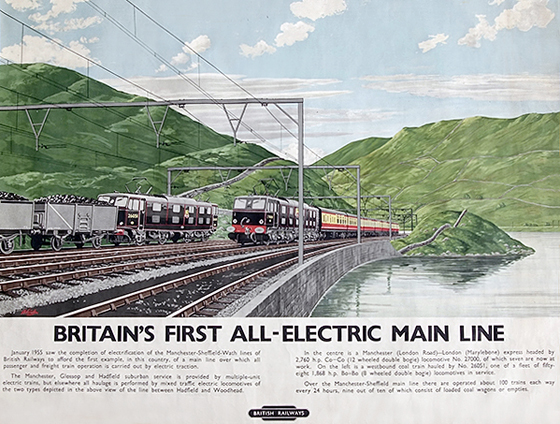
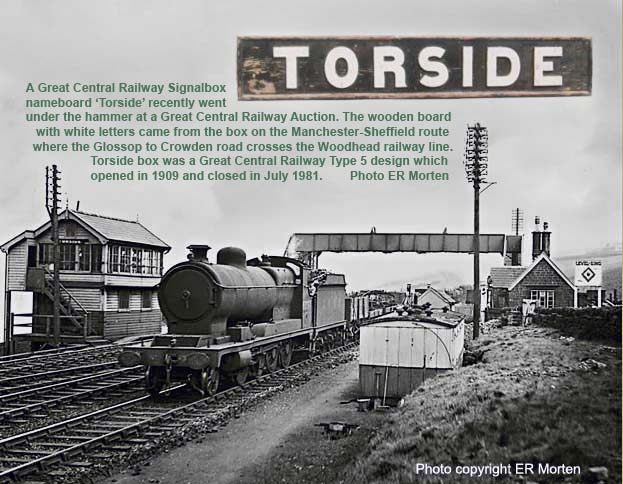
(Above) Woodhead steam days: In 1911, JG Robinson, then Chief Mechanical Engineer of the Great Central Railway 1900-1922, designed a 2-8-0 heavy freight engine in anticipation of the additional traffic being generated by the company's new docks at Immingham and a large marshalling yard at Wath-on-Dearne in the South Yorkshire coalfield. At the outbreak of the First World War, the Robinson design was chosen by the British Army for war service overseas, and a total of 344 was ordered for the Railway Operating Division (ROD) of the Royal Engineers. After grouping, no fewer than 421 locomotives were acquied by the LNER, including No 6337, seen here hauling a heavy coal train through the drizzle at Torside in 1939. (Below) Fast-forward 14 years and Mr Morten is greeted by yet another spell of inclement weather at Crowden as Class 04/8 No 63750 heads a 'down' fright on 15th August 1953.
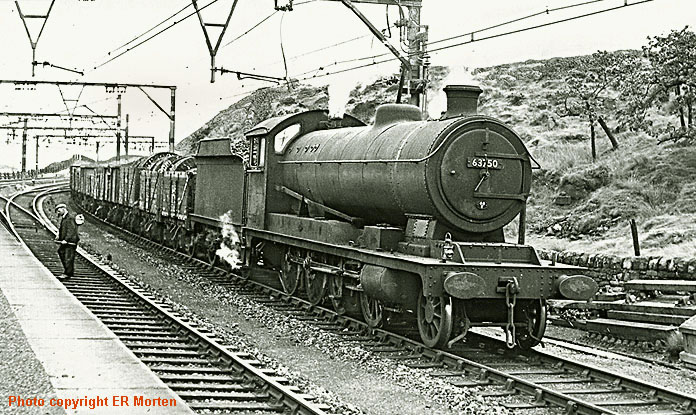
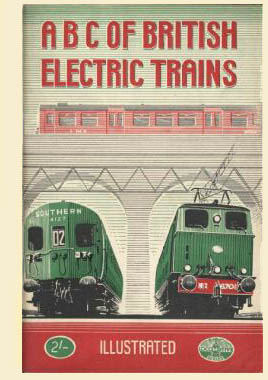 (Below) In 1939, the LNER embarked upon electrifying the former Great Central main line from Sheffield to Manchester using the Government recommended standard 1,500-volt dc, with overhead line current collection. At the outbreak of World War 2, work was halted and the electrification did not start again until February 1952 when the Wath-Penistone section was energised. By May 1954, electric trains began running through Woodhead Tunnel, but the Manchester to Penistone section was not fully energised until June. The Sheffield Victoria to Penistone section followed in September and the final few miles from Sheffield Victoria to Rotherwood was opened in January 1955 - the same year that the BR Modernisation Plan was announced (including in its proposal the electrification of the WCML). It was generally assumed that the 1,500 volt dc system would be the future British standard, but the BTC adopted the 25kv 50-cycle ac system as used on the French National Railways. Orders were placed for two types of locomotive, EM1 and EM2. Designed by Gresley and Metro-Vickers, a total of 57 Class EM1 Bo-Bo (later TOPS Class 76) were built primarily for use as freight locomotives originally numbered 26000-26057 in the fleet.
(Below) In 1939, the LNER embarked upon electrifying the former Great Central main line from Sheffield to Manchester using the Government recommended standard 1,500-volt dc, with overhead line current collection. At the outbreak of World War 2, work was halted and the electrification did not start again until February 1952 when the Wath-Penistone section was energised. By May 1954, electric trains began running through Woodhead Tunnel, but the Manchester to Penistone section was not fully energised until June. The Sheffield Victoria to Penistone section followed in September and the final few miles from Sheffield Victoria to Rotherwood was opened in January 1955 - the same year that the BR Modernisation Plan was announced (including in its proposal the electrification of the WCML). It was generally assumed that the 1,500 volt dc system would be the future British standard, but the BTC adopted the 25kv 50-cycle ac system as used on the French National Railways. Orders were placed for two types of locomotive, EM1 and EM2. Designed by Gresley and Metro-Vickers, a total of 57 Class EM1 Bo-Bo (later TOPS Class 76) were built primarily for use as freight locomotives originally numbered 26000-26057 in the fleet.
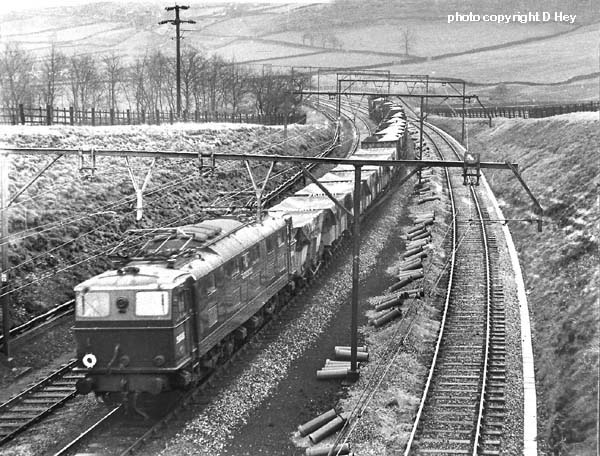
(Above-Below) The Class EM1 Bo-Bo (later TOPS Class 76s) were primarily freight locomotives originally numbered 26000-26057 in the fleet, however the final batch of 12 locomotives were fitted with a train heating boiler for passenger work, including No 26047 Diomedes, seen here heading a rake of 16-and-20 ton mineral wagons near Penistone on 1st April 1961. (Below) Class 04 2-8-0 No 63573 heads a westbound freight through Hazlehead Bridge station in April 1952. Hazelhead station closed to passengers in March 1950 and goods traffic ceased in May 1964. Photos © D Hey, ER Morten.
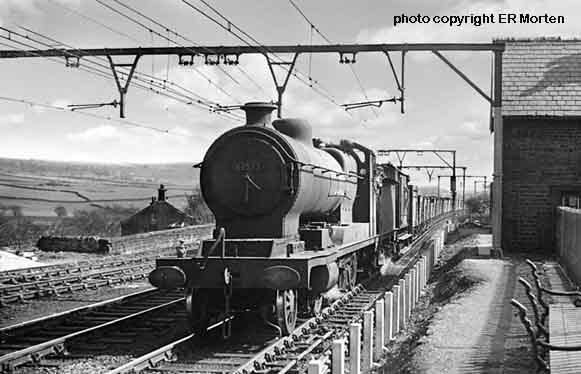

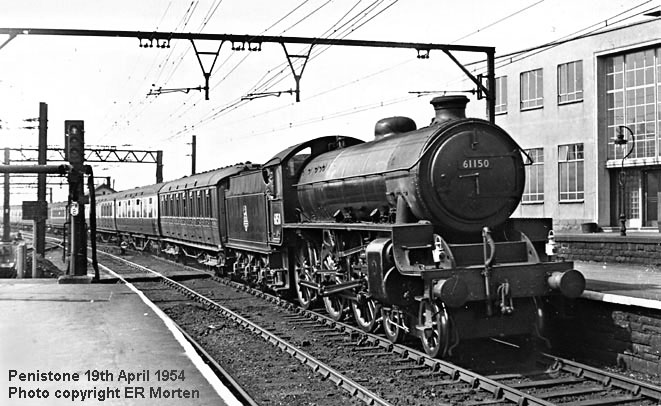
Above) Class B1 No 61150 enters Penistone with an 'up' train on 19th April 1954. You'd be forgiven thinking that the building on the right is the local 'Odeon' cinema; its Art Deco style is typical of the Twentieth Century architecture that sprang up in the 1920s and 1930s. The building is in fact the Penistone Control Centre, which was responsible for power along the Woodhead route. The exterior is not quite as flamboyant as some examples of Art Deco architecture, but it is a striking design with a flat roof and large windows that reflected the clean-cut image of the LNER's new electrified route. Art Deco began at the Paris Exhibition in 1925, its style influenced by Cubism - zigzags and geometrical shapes - along with Ancient Egyptian after the discovery of the tomb of Tutankhamen in 1922, and Aztec art from South America and Mexico. In those days Art Deco designers and architects exploited the new innovations of concrete, plastics, chrome and aluminium, their new style mirroring the latest streamlining and speed in travel - commercial flights, ocean-going liners and trains; the distinctive house style applied to London Transport Underground Stations being a classic example. As the Twentieth Century slips further away, the importance of preserving buildings in the classic Art Deco style is gaining proper recognition - the LMSR's Midland Hotel on the seafront at Morecambe being another classic example.
Ever since Mr Morten's railway photos first appeared on the Internet a lot of people have expressed interest in buying his work. All enquiries regarding the purchase of photographs should be made to Jeremy Suter at pa.suter@tiscali.co.uk (In order to avoid spam this is not a 'clickable' mail-to link). Also please note I am not affiliated with the sale of ERM's photos in any way, merely passing on a genuine contact address.
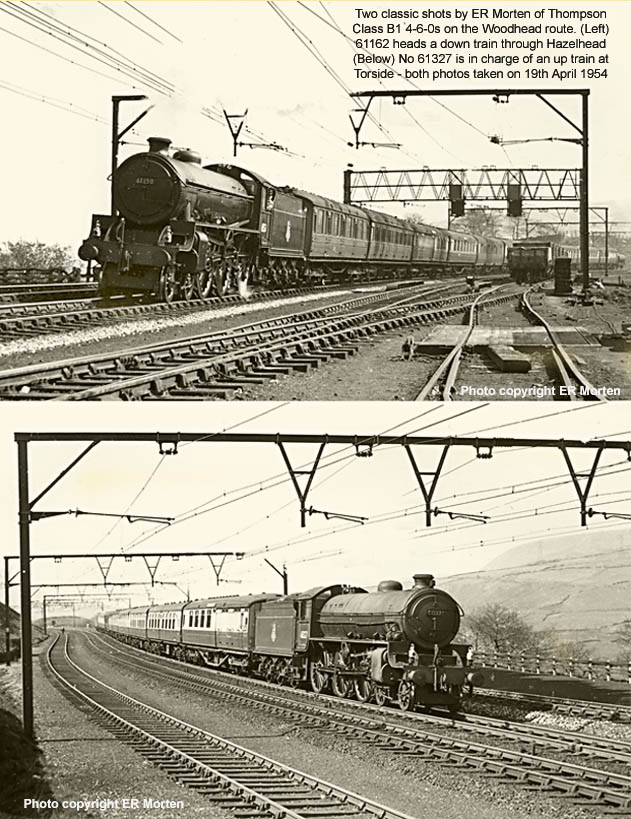

(Above) Although the benefits of 1950's electrification over the Woodhead route were immediately apparent, particularly on the heavy coal trains, by 1965 the non-standard equipment was becoming life expired and in 1970 all passenger services were re-routed via the Hope Valley line, though the Woodhead line remained open as a dedicated freight route and for use by special trains and 'Footex' (Football Excursions). The 1969-70 Football season saw Manchester United playing Leeds United in an FA semi-final at Hillsborough, Sheffield on 14th March 1970. BR routed six specials for Manchester fans via the Woodhead line hauled by a Class 50 No D414, a 'Peak' class, a pair of Class 25s and three Class 40s including No D235 Apapa, seen climbing to Woodhead Tunnel at Torside. For the record, the match ended in a 0-0 draw, as did the replay at Villa Park, but Leeds beat Manchester 1-0 in the second replay at Burnden Park, Bolton. However, Leeds United's marathon run of matches was far from over - having finished the 1969-70 season runners up to 1st Division Champions Everton, they faced Chelsea in the FA Cup Final at Wembley on 11th April 1970; the result was similarly deadlocked (2-2) with Chelsea eventually running out 2-1 winners in another replay held at Old Trafford.
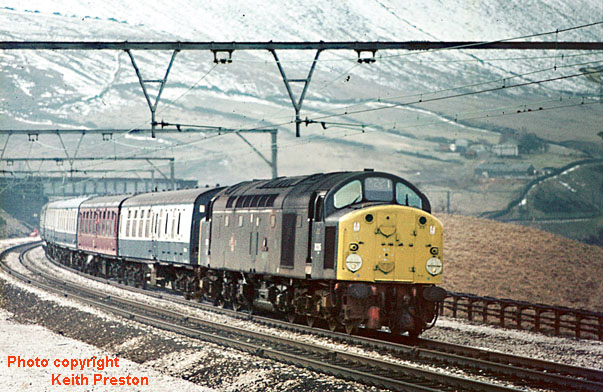
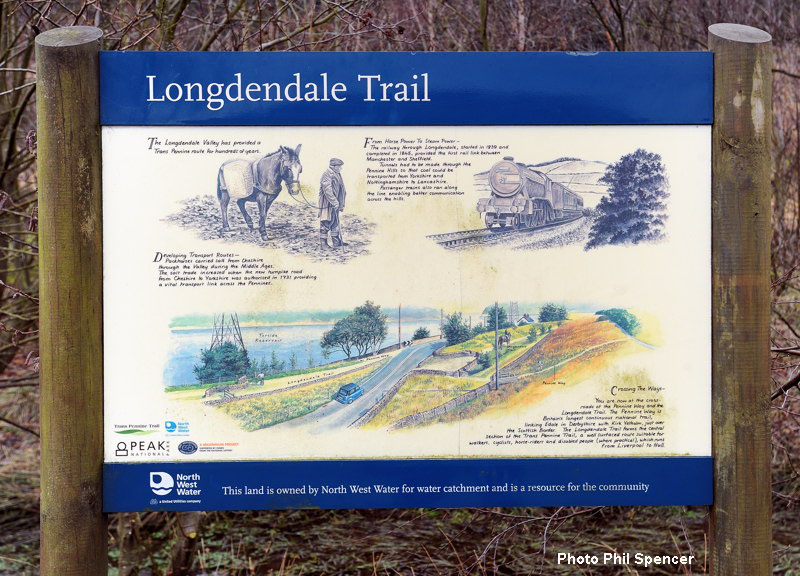
(Above) Since closure of the Woodhead route between Manchester and Sheffield, a stretch of the abandoned trackbed has been converted into the Longdendale Trail, which runs through the picturesque Upper Longdendale Valley, just north of Glossop in the Peak District National Park. The trail forms the central section of a much longer Trans-Pennine Trail that runs from coast to coast across the UK between Liverpool and Hull. The Longdendale Valley provides a natural catchment area for the rainwater running off the surrounding moorland hills, hence a chain of reservoirs was constructed in the 19th Century to serve Lancashire's once-thriving cotton and paper mills, and to provide fresh drinking water for Manchester. Today the Longdendale Trail is owned and managed by United Utilities, providing a variety of recreation activities, such as horse riding, cycling and walking. It is also suitable for less agile people and families with small children. You can get on to the Longdendale Trail at Hadfield and at Woodhead - the trail is just over 6 miles long between both points. However, the most popular access point is the old level crossing at Torside, which is the crossroads of the Pennine Way, the longest continuous national trail in Britain linking Edale in Derbyshire to the Scottish Border.
(Below) I am pleased to add a few 'gems' of old steam days from ER Morten's photo collection. The masts are up in readiness for electrification as Class B1 No 61187 approaches Torside with a 'down' special on 30th June 1951. (Right) As you stroll along the old railway today, spare a thought for the men who worked the heavy coal trains from the Yorkshire coalfied to the industries of Lancashire. Here, War Department Class 'WD' 2-8-0 slogs up the incline at Crowden with an 'up' freight on 30th June 1951. 
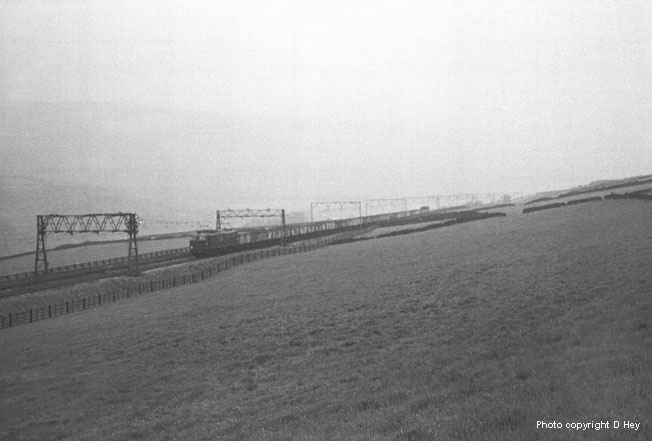
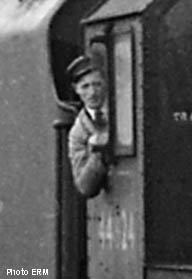 (Above) Does the sun ever shine in Longdendale? It never did for me! This photo revives more cheerless memories of a wet day at Torside in April 1961. Just visible in the distance is Torside signal box.
(Above) Does the sun ever shine in Longdendale? It never did for me! This photo revives more cheerless memories of a wet day at Torside in April 1961. Just visible in the distance is Torside signal box.
(Below) The former LNWR Standedge route between Huddersfield and Stalybridge has become the principal east-west route across the Pennines. The photo (inset) shows the footplateman enjoying a welcome breath of fresh air (note the collar and tie) as 'Black 5' No 44824 emerges from the 3 mile 57 yard-long single-bore 'Nelson' tunnel at the Diggle end (the station closed 5th October 1968). This 1871 tunnel was the second of three railway tunnels to be built, the first being the single-bore 'Nicholson' tunnel of 1849. However, to facilitate the increase in LNWR traffic a new double bore tunnel was built in 1894, and this is still in use today. An oddity of the Standedge railway tunnels is that they provided the only level section of track over the Trans-Pennine route where water troughs could be installed (at the Diggle end) which explains the copious amount of steam in ER Morten's atmospheric shot.
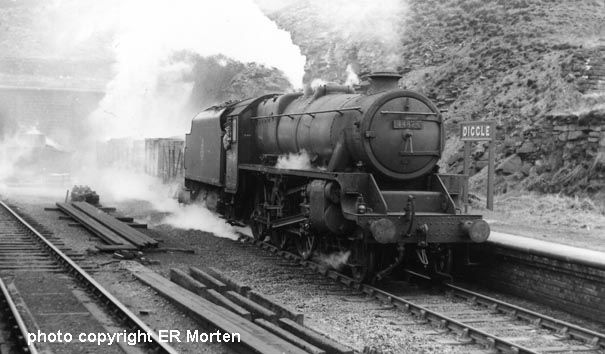
(Below) Fast-forward to April 2009 and the scene has changed dramatically at Diggle following closure of the station in 1968. The extent of rationalization at Diggle can be clearly seen in these striking 'Before-After' shots taken from above the single-bore portals of Standedge Tunnel looking towards Manchester. Click on photos to enlarge
LOST RAILWAYS OF CUMBRIA
Moving across the country to Cumbria, one of the most scenic lines to found anywhere in Britain was the Cockermouth, Keswick and Pemrith (CK&P) railway, which was built primarily as a mineral line in 1864 to provide a link between Workington and  Darlington via the Stockton & Darlington Railway's Stainmore route across the Pennines. In the final years of steam operation, the line was dominated by ex-LNWR locomotives and later Ivatt's Class 2MT 2-6-0s, both classes being designed specifically for light branch line work.
Darlington via the Stockton & Darlington Railway's Stainmore route across the Pennines. In the final years of steam operation, the line was dominated by ex-LNWR locomotives and later Ivatt's Class 2MT 2-6-0s, both classes being designed specifically for light branch line work.
The line was dieselised in February 1955, consisting of thirteen brand new 'Derby Lightweight' dmus which operated eight trains daily in each direction. With a driving cab at either end, the new dmu operations were extremely flexible as the vehicles could work in both directions, thus avoiding the untidy manoeuvre of an engine running around the stock to couple up again. However, the introduction of dmus on a rail network predominated by steam brought with it several problems. By its very nature, diesels require a clean working environment, therefore suitable premises had to be found for the stabling and maintenance of sets. The  first batch of 'Derby Lightweight' dmus destined for the West Cumberland services were maintained at Carlisle Upperby carriage sheds and at Workington's steam shed 11B, where five tracks were partitioned off specifically for the purpose.
first batch of 'Derby Lightweight' dmus destined for the West Cumberland services were maintained at Carlisle Upperby carriage sheds and at Workington's steam shed 11B, where five tracks were partitioned off specifically for the purpose.
(Left-Below) The NMSI Collections Online is a superb website displaying countless thousands of objects including a range of fabulous railway travel posters...a visit HERE is highly recommended. (Inset) This poster depicts a 2-car 'Derby Lightweight' diesel multiple unit in green livery, passing over a brick bridge on a sunny day, with white clouds in the sky. The text beneath it gives details of improved services between Whitehaven, Workington, Carlisle, Penrith, Keswick and Silloth. (Below) This BR (LMR) poster from the NMSI's website depicts.a BRCW 2-car diesel multiple unit (later TOPS Class 104) on the shore of Bassenthwaite Lake near Keswick, painted by Barber. The text reads - 'Diesel trains are now well established and extremely popular. Holidaymakers, shoppers and commuters all find them a great attraction. Their observation windows are excellent for sightseeing. Among the lovely holiday areas served by London Midland diesel trains are English Lakeland and North Wales, where reasonable priced Day Trips and Runabout Tickets (in the season) help you to get around and about'.
In 1963 the Beeching Report recommended closure of the CK & P line in the heart of the English Lake District. Following the withdrawal of goods traffic on 1st July 1964, BR announced its intention to close the entire route in April 1966 - a decision coincident with the Ministry of Transport's plans for using part of 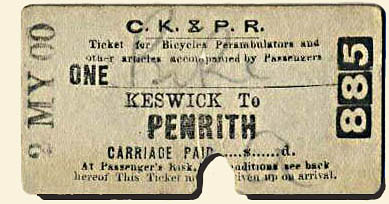 the line for an improvement scheme on the main A66 road…I have to say, it just about sums up Governments' injudicious bias towards road transport! Indeed, as a textbook exercise in turning a problem into a major disaster, the Government's handling of railway closures took some beating. There are no short cuts, except to the wrong answers, and BR certainly found a few, though much of the blame lies at the door of Government for rushing into closures too fast. Had only Beeching's original 1963 plan for axing 5,000 route miles of track and 2,363 stations been handled with more prudence, then many sizeable towns like Keswick would still have a direct link to the railway network today. Of course, if one accepts the figures quoted for the maintenance of some lines, then BR made a plausible case for closure, and in many ways it is surprising that some branch line traffic survived as long as they did. But then, considering the potential of the CK&P line as a tourist route in one the country's most scenic regions, the idea of closure smacks to me of incompetence on a massive scale - and in case anyone is wondering what all the shouting is about these late evening views of Keswick and Derwent Water in the early Sixties shows something of the spectacular scenery to be found in the Lake District.
the line for an improvement scheme on the main A66 road…I have to say, it just about sums up Governments' injudicious bias towards road transport! Indeed, as a textbook exercise in turning a problem into a major disaster, the Government's handling of railway closures took some beating. There are no short cuts, except to the wrong answers, and BR certainly found a few, though much of the blame lies at the door of Government for rushing into closures too fast. Had only Beeching's original 1963 plan for axing 5,000 route miles of track and 2,363 stations been handled with more prudence, then many sizeable towns like Keswick would still have a direct link to the railway network today. Of course, if one accepts the figures quoted for the maintenance of some lines, then BR made a plausible case for closure, and in many ways it is surprising that some branch line traffic survived as long as they did. But then, considering the potential of the CK&P line as a tourist route in one the country's most scenic regions, the idea of closure smacks to me of incompetence on a massive scale - and in case anyone is wondering what all the shouting is about these late evening views of Keswick and Derwent Water in the early Sixties shows something of the spectacular scenery to be found in the Lake District.
(Above-Below) By the early Sixties BR's dmu programme was well advanced, but it would take several years before the new stock was introduced in the Cumberland area. (Above) Sporting a yellow chevron on its front end, a 2-car set forms the 11.10 Carlisle-Penrith-Keswick-Workington at Cockermouth on 8th September 1959. (Below) On August 14th 1963, Mr Carr returned to the Lake District to update his photographic collection and took this shot of two early 'Derby Lightweights' standing side-by-side at Bassenthwaite Lake station, situated on the very shores of the lake (the main station building also functioned as a rural post office). The diesel units now carry a small rectangular warning panel and the yellow diamond coupling code symbol has been added above the buffer beams. The two platforms at Bassenthwaite Lake provided a passing loop for the single line section west of Keswick, but this fell victim to the Beeching axe on April 16th 1966, and the Penrith-Keswick line became a dead-end branch. Photos copyright IS Carr
(Above) In some cases, the Minister of Transport showed leniency to curb the excesses of the Beeching Plan by approving only partial closure of a line, but it wasn't until the 1970s that Government  showed a more tolerant attitude towards socially useful lines. By then it was too late for the CK&P, because once the Genie was let out of the bottle, it could not be forced back in, as there was no machinery in place to reverse a closure notice which had already been approved by the Minister of Transport. So in spite of the savings from singling the line (and the replacement of the elderly 1955 units with modern Class 108 dmus in 1969) the reprieve for Keswick residents was short-lived and the Penrith-Keswick section finally gave way to closure on March 6th 1972.
showed a more tolerant attitude towards socially useful lines. By then it was too late for the CK&P, because once the Genie was let out of the bottle, it could not be forced back in, as there was no machinery in place to reverse a closure notice which had already been approved by the Minister of Transport. So in spite of the savings from singling the line (and the replacement of the elderly 1955 units with modern Class 108 dmus in 1969) the reprieve for Keswick residents was short-lived and the Penrith-Keswick section finally gave way to closure on March 6th 1972.
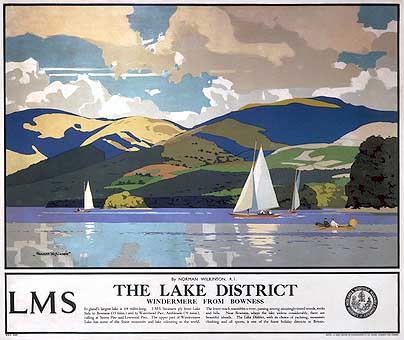
(Above-Below) Another fine example of Norman Wilkinson's quality artwork that adorned an LMS railway travel poster, this one showing sailing boats on Lake Windemere. Sir Norman Wilkinson CBE (1878 -1971) was primarily a marine painter who worked in oils, watercolors and drypoint, but he was also an illustrator, poster artist, and wartime camoufleur who first proposed the use of disruptive coloration in naval  camouflage during WW1, and coined the well-known term 'dazzle painting'. (Below) The former LMSR branch from the WCML at Oxenholme to the terminus station at Windermere mercifully survived the Beeching axe, albeit today's station is a shadow of its former self. The station used to have four platforms and an overall roof, but a year after goods traffic ceased in 1972 three tracks were taken out of use as an economy measure and the branch was reduced to a single line leaving just a solitary platform served by one terminal track. Following demolition of the trainshed a new station was built and a supermarket now occupies the site of the original station building. Memories of old LMS days - and horses and carts come to that - can be seen in this ER Morten shot of a Stanier 2-6-4T No 2594 awaiting departure from the terminus in 1945.
camouflage during WW1, and coined the well-known term 'dazzle painting'. (Below) The former LMSR branch from the WCML at Oxenholme to the terminus station at Windermere mercifully survived the Beeching axe, albeit today's station is a shadow of its former self. The station used to have four platforms and an overall roof, but a year after goods traffic ceased in 1972 three tracks were taken out of use as an economy measure and the branch was reduced to a single line leaving just a solitary platform served by one terminal track. Following demolition of the trainshed a new station was built and a supermarket now occupies the site of the original station building. Memories of old LMS days - and horses and carts come to that - can be seen in this ER Morten shot of a Stanier 2-6-4T No 2594 awaiting departure from the terminus in 1945.

(Above-Below) Regular contributor Ray Hindle has been trawling through his old slides and came across this one, albeit not technically railway, it is rail orientated. It shows SY Swift on Windermere in the very early eighties (must be VERY early as she was taken out of service in 1981). A lot of people forget that the railways operated a fleet of four steamers on Windermere. Originally, operated by the Furness Railway from 1900 to 1922 then post-grouping by LMS until nationalisation. She was withdrawn from service in 1981, and later used as a floating museum dedicated to world waterspeed record attempts by the Campbell family. Unfortunately, she was allowed to deteriorate, and despite attempts at preservation, was broken up in 1998.  The other three vessels - Swan (built 1936); Tern (Built 1890) and Teal (built 1936) remain in service with what is now Windermere Lake Cruises. There is a good webpage devoted to services on Windermere here. (Below) This July 1962 shot shows Lake Side Station - another remarakable survivor of the Beeching era, and so too is the Metro-Vick D5705. (Inset) A BR London Midland Region totem went under the hammer at a Great Central Railwayana Auction. The station sign came from the terminus of the Furness Railway's branch from Ulverston to Lake Windemere which closed on 6th April 1964 - a lovely name and an idyllic setting - now the terminus of the Lakeside and Haverthwaite Railway. At least we can take our leave of Cumbria on an upbeat note...
The other three vessels - Swan (built 1936); Tern (Built 1890) and Teal (built 1936) remain in service with what is now Windermere Lake Cruises. There is a good webpage devoted to services on Windermere here. (Below) This July 1962 shot shows Lake Side Station - another remarakable survivor of the Beeching era, and so too is the Metro-Vick D5705. (Inset) A BR London Midland Region totem went under the hammer at a Great Central Railwayana Auction. The station sign came from the terminus of the Furness Railway's branch from Ulverston to Lake Windemere which closed on 6th April 1964 - a lovely name and an idyllic setting - now the terminus of the Lakeside and Haverthwaite Railway. At least we can take our leave of Cumbria on an upbeat note...
(Below) Strictly speaking, the history of Cumbria's narrow gauge lines has nothing to do with the Beeching era, but I include this photo to illustrate that there are losers whatever the size! This rickety old narrow gauge railway at Honister Pass is a legacy of the area's once-thriving quarrying business, and goes to prove that no matter how big or small, Britain's railways have played a pivotal role in this nation's industrial past. But what of the future? Doubtless we'll all be wearing aluminium foil suits and flying around in jet cars. At least it'll give us a chance to view the derelict remains of our railway heritage from the air, since much of the rail network has disappeared beneath supermarket car parks and industrial estates, or shrouded by trees and shrubs. One can't help wondering how scholars in the future might stumble upon a pile of rubble in a field that was once a railway station and debate its purpose, and how it got there - as archaeologists speculate the origins of Stonehenge.
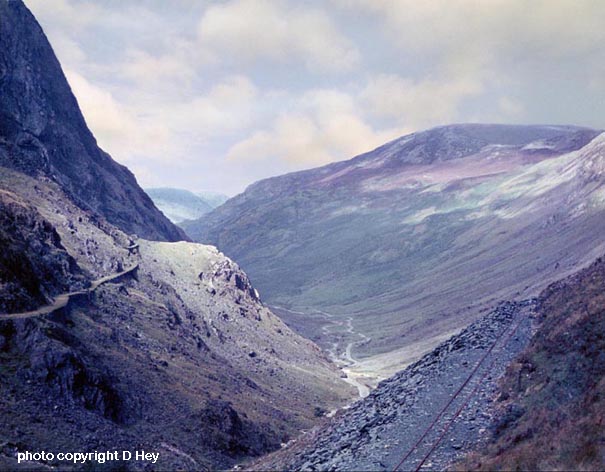
The demolition of our railway heritage and removal of track was carried out with indecent haste, yet if only the track had remained, then even a closed line was still a railway, but there is an awful finality about ripping up track, because once that is done, a railway is truly dead and ghost's laid. If only we could turn  back the clock and cast a magic spell on Beeching and his cronies by uttering the tongue-twisting 'supercalifragilisticexpialidocious' from the 'Mary Poppins' film of 1964...and then what? Well, think jump lead, genetalia and third rail...no I couldn't possibly comment further!
back the clock and cast a magic spell on Beeching and his cronies by uttering the tongue-twisting 'supercalifragilisticexpialidocious' from the 'Mary Poppins' film of 1964...and then what? Well, think jump lead, genetalia and third rail...no I couldn't possibly comment further!
All things considered, there is no escaping the grim reality of Beeching's legacy. This is well documented on some websites which graphically portray the Beeching era at its capricious worst. Let me be quite honest about this, the Beeching mandate for re-shaping Britain's railways offered no real solution in curing BR's financial ills. Instead, the disturbing truth that emerged from the carnage is that many once-proud Victorian railways were mindlessly razed to the ground. I recommend the following sites...
'Disused Stations UK' website: Nick Catford is building up a comprehensive database of Britain's railway heritage with details of closed stations, each one featuring history, photographs, tickets, timetables and a handy map references showing the location of every station. The research material will eventually be affiliated to the Subterranea Britannica web site.
Beeching Axe - part of Joyce's World of Transport Eclectia. The site contains various maps of the British Railways network in 1961, before the infamous 'Beeching Report' and the pruning of many branch and secondary lines. The second set are from 1969. Chris Tolley's website is a must visit for students of railway history. It includes a comprehensive list of maps and railway junction diagrams pre-1923 plus an 'honest to goodness' commentary on the subject of copyright and Acceptable Use Policy that all web users should read...
Lost Railways West Yorkshire - it's good to see this site going from strength to strength! If you are seeking evidence of Beeching's effect on Britain's railways in the Yorkshire region, or anywhere in Britain for that matter, this is one of the best sites on the web...
(Above-Left) 1960's views from Blackpool Tower - Blackpool's now-closed Central Station - once the terminus of the direct route from Preston. (Above Right) North Shore looking towards Fleetwood. (Below) Opened in 1846, Blackpool Talbot Road station was rebuilt in 1898 to facilitate the growing number of holidaymakers to this popular resort. The two parallel train sheds (with arched roofs) contained platforms 1 to 6 and new excursion platforms 7 to 16 were in the open and used during the summer season. The platforms look fully occupied in this 1961 view, with steam much in evidence both on excursion traffic and in the shed yard. In 1974 the main station was demolished to make way for a supermarket; the current North station is based on the former excursion platforms. Click on photos to enlarge images...
![]() Don Maplin from York writes: 'I was interested in your comments about closure notices being based on doctored figures. You should read Andrew Sefton's website about Pocklington's history in the Yorkshire East Riding. When the Minister gave consent to the axing of passenger services on the York-Hull route via Beverley on November 29th 1965 it caused widespread bitterness. It appears that there had been some slip-up over the alleged losses; the BRB stated at the public inquiry that the losses had been reduced by dieselisation and improved working to some £11,000. Yet the Ministry spoke of an annual deficit of some £100,000, and a gentleman at Pocklington (who organised a protest) wondered, quite seriously, whether some secretary had typed one nought too many! Regards, Don.'
Don Maplin from York writes: 'I was interested in your comments about closure notices being based on doctored figures. You should read Andrew Sefton's website about Pocklington's history in the Yorkshire East Riding. When the Minister gave consent to the axing of passenger services on the York-Hull route via Beverley on November 29th 1965 it caused widespread bitterness. It appears that there had been some slip-up over the alleged losses; the BRB stated at the public inquiry that the losses had been reduced by dieselisation and improved working to some £11,000. Yet the Ministry spoke of an annual deficit of some £100,000, and a gentleman at Pocklington (who organised a protest) wondered, quite seriously, whether some secretary had typed one nought too many! Regards, Don.'![]() PR from Australia writes - 'At least you haven't had the ridiculous stuff we've had here in Queensland. The line from Brisbane to Southport (Gold Coast) and Coolangatta (NSW border) was cut back to Beenliegh in the 60's for the same sort of reasons as the Beeching cuts - falling freight services and declining passenger services.
PR from Australia writes - 'At least you haven't had the ridiculous stuff we've had here in Queensland. The line from Brisbane to Southport (Gold Coast) and Coolangatta (NSW border) was cut back to Beenliegh in the 60's for the same sort of reasons as the Beeching cuts - falling freight services and declining passenger services.
One of the problems with the line was an ancient bridge that meant only very small steam locos could continue on past a town called Beenligh at about the half way point.
The cost of the bridge renewal was estimated at $2 mil - about $8mil now.
So they ripped the line up.
Forty years later they spent upwards of a $200 mil building a new line to the Gold Coast... they couldn't even take it to Southport anymore because the land had been sold off and is now worth a fortune.
DERRRR!!!
Oh and they will be spending even more to extend it all the way back to Coolangatta where it used to run…about another 10 miles…these are only approximate figures of course...
The whole Beeching thing seems to have been an episode of corporate blindness though your passing comment about Marples' vested interests is always worth bearing in mind. One factor which often seems to be overlooked is that the tracks and/or track beds remained for many years after the Beeching fiasco. Many of the "lines" didn't finally disappear until the 80s when that well-known hater of the railways, M. Thatcher, decreed that BR land had to be sold off (all part of the preparation for privatisation). I was living in the East Midlands at the time and I well recall lines finally disappearing around Nottingham and Leicester. Oh, that someone, somewhere had had some foresight. As a Geordie, I am always a bit chuffed that the Tyneside Metro came about, the Tyneside rail system having hung on through all this although the original concept of the Metro was damaged when deregulation of buses came about - under, guess who?...yes, M. Thatcher.
I currently live in France between Nantes and Rennes. Both have well-developed trams and/or metros and there is to be a reopening of some local railway lines as TramTrains running into the Nantes tram system. Here, of course, the tracks weren't sold off!
Doesn't the whole thing seem like one huge missed opportunity and a betrayal?
Cheers, John Vasey.'
Polite notice: All text and photographs are protected by copyright and reproduction is prohibited without the prior consent of the © owners. If you wish to discuss using the contents of this page the email address is below. Please note - this is not a 'clickable mail-to link via Outlook Express:
dheycollection@ntlworld.com


